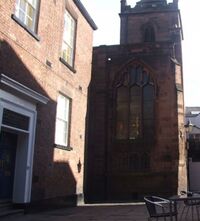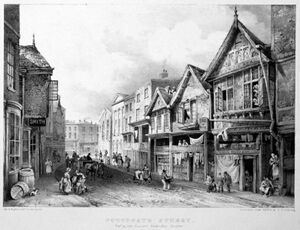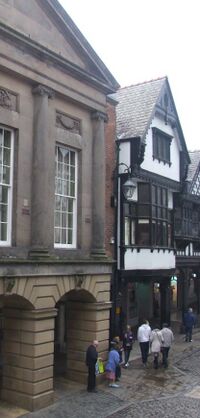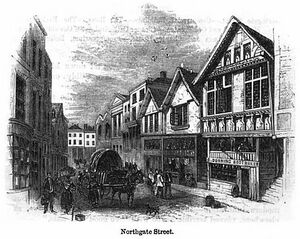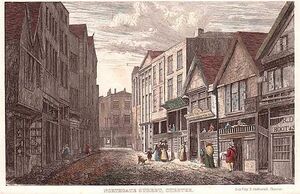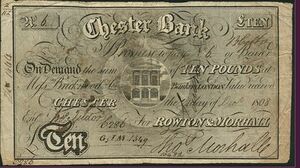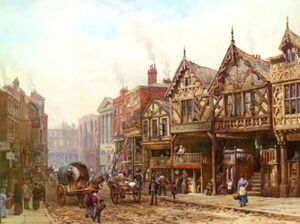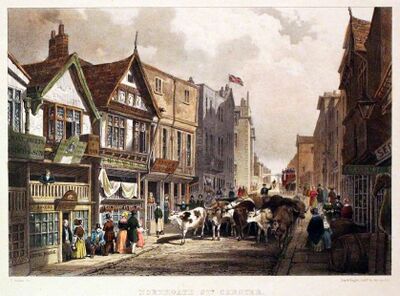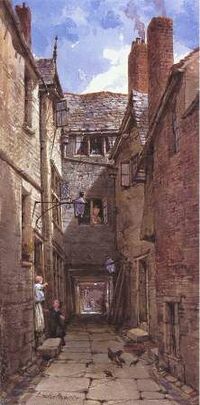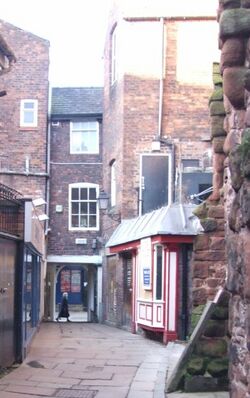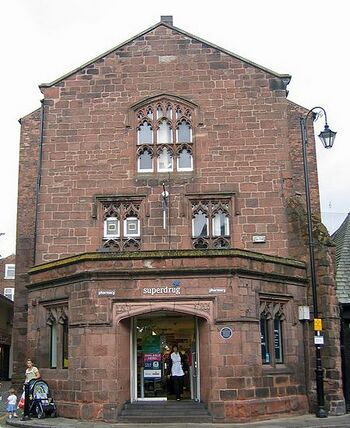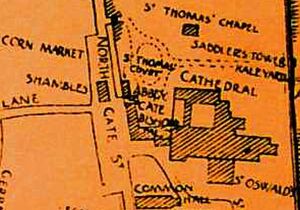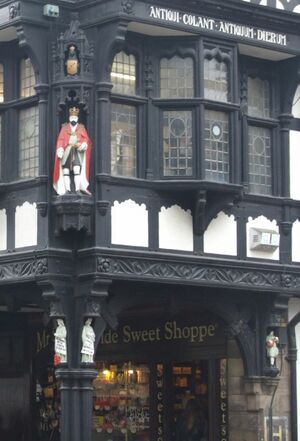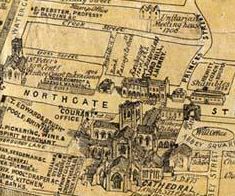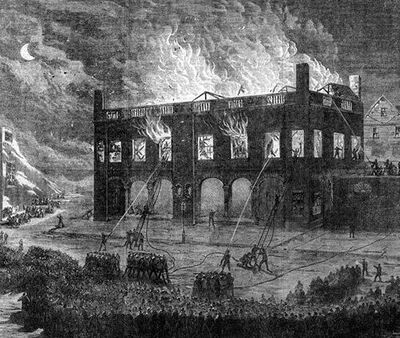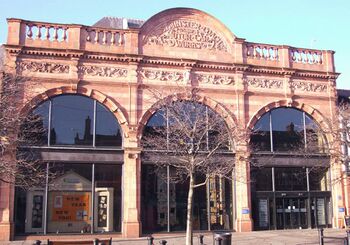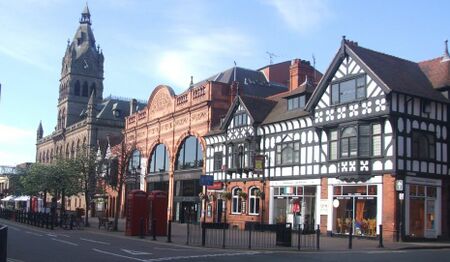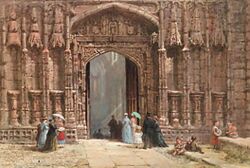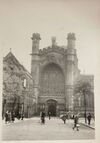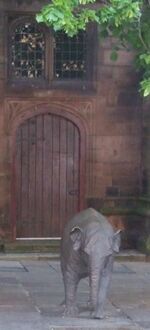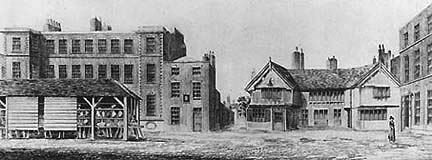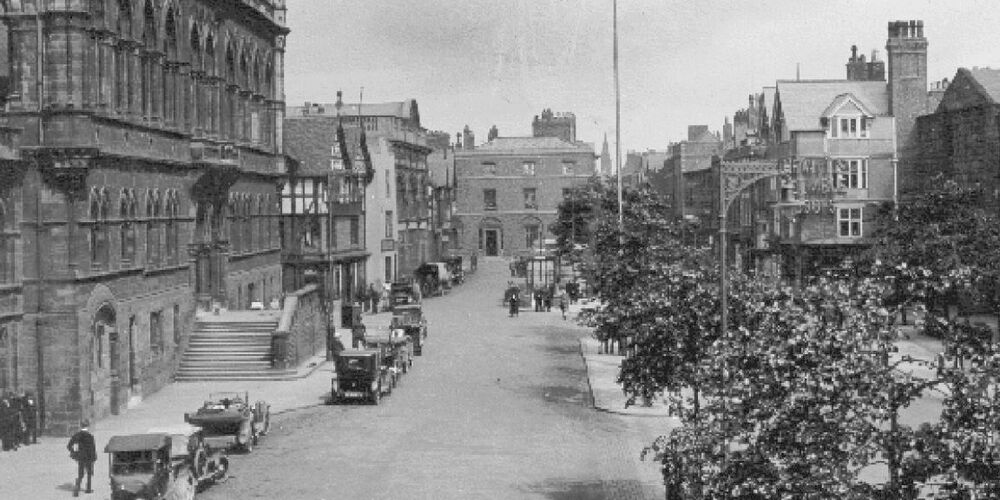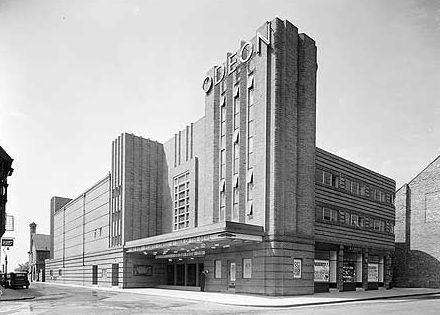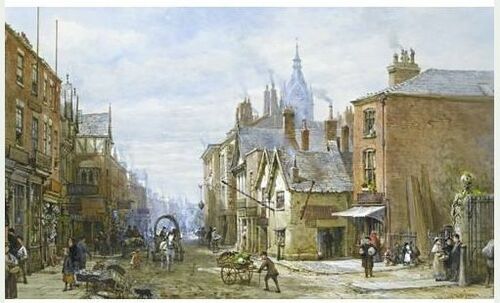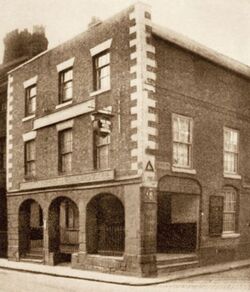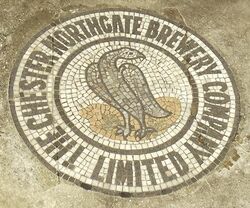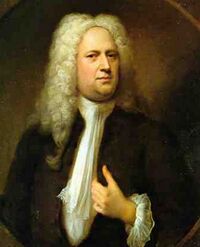Database changes have finished applying - please report any issues you're (still) seeing to support@shoutwiki.com.
Northgate Street
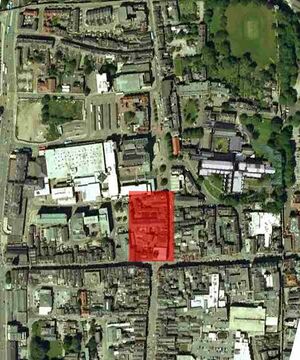
Northgate Street, along with Bridge Street, Watergate Street and Eastgate Street, is one of the four original streets built inside Roman Chester. All four streets meet at the High Cross. Braun and Hogenberg's map of 1581 shows that the area was fully occupied with buildings. The main feature of later development has been the amalgamation of plots to create larger holdings, and the development of former gardens to fill in the "backlands" to either side of the street.
Over the years Northgate street has been home to many taverns, inns and places of entertainment ChesterWalls.info has a list of vanished pubs in Northgate Street. In Roman Chester the street was the "Via Decumana", and ran from near the cross to the Northgate. Roman Northgate street had to take a "dog leg" to avoid the "Principa" (Headquarters Building), which stood on the site of St Peter's Church. Across Roman Northgate Street from the Principia stood the "Praetorium" which was the private accommodation of the Roman Legate - the most important man in the Roman City. Eastgate Street North Row and the Northgate Street East Row have been collectively known in the past as Pepper Alley Row (1894), from the name of the alleyway towards St. Werburgh's churchyard - it is probably an instance of the modern use of 'pepper' for a rowdy person, a hooligan. The Row was the site of The Butter Shops from 1280 to 1590 - It was Baxter Row or Baker's Row from 1293 to 1502 - also "le Cokesrows" (the cook's row) from 1330 to 1449. Pepper Alley Row belonged to Reginald de Thlene of Leen Lane in 1330. Another name for Pepper Alley Row is The Dark(e) Row (1591 to 1650) - the earlier form of this name was "le Dirke Loftez" (1488), or "le Darke Loftes" (1541).
Further from the High Cross, the character of Northgate Street changes. It widens out with a modern shopping center and the Town Hall on one side and the Cathedral precincts on the other. After that things change again, with the street continuing to the Northgate itself and very little of Chester's typical "mock Tudor".
In June 2015 Northgate Street was rated "among the top 50 crime hot-spots in Britain". A problem cluster saw 37 offences recorded in April putting it joint 28th in the worst 50 trouble spots for crime in England and Wales.
- Northgate Street in the Chester Archaeological Society Characterisation Study;
Listed (and other) Buildings in Northgate Street

Seacome says of it:
- "In Northgute strect the Rows now extend nearly from the Cross to the Fish Market on the west side and to Smith's Entry on the east. That on the west is named Shoemaker's Row and that on east appropriately enough Broken Shin Row. These as well as the Watergate street Rows are chiefly formed of wood and retain all the inconveniences of antiquity unsophisticated by the innovating hand of modern improvement".
Northgate Street Row (North)
Number #1: Commercial News Rooms
Number 1 is an impressive Neo-Classical building (built 1807) designed by Thomas Harrison. On the front facing Northgate Street the lower storey consists of a rusticated three-bay arcade, set behind which are modern shop fronts. The walkway in front of the shop-fronts is not an original feature but was inserted somewhat crudely in the 1960's. In the upper storey are four Ionic pilasters dividing it into three bays, each of which contains a 24-pane sash window. The Strangers Companion in Chester (Batenham - 1827) describes it thus:
- The Commercial Buildings next attract notice which were erected for and now occupied as a subscription news room the back of the same premises are rented as a public subscription library and on the ground floor are two handsome shops.
Seacome, a bookseller of Chester by trade, tells us a little more in 1828:
- ..a handsome pile of architecture having a highly finished stone front of the Ionic order situated on the west side of Northgate street adjoining St Peter's Church The ground floor is occupied by two handsome shops the first floor by the Commercial News Room and the second by the City Library. The COMMERCIAL News ROOM is a spacious apartment 45 feet long by 26 wide having a fire place at each end. There are 100 proprietors or this Institution by whom every facility is given to the introduction of strangers of respectability. Earl Grosvenor and the Mayor are Honorary Members with the privilege of introducing an unlimited number of strangers. The liberty of attending the room is also allowed to the Members for the City and County. A variety of London and provincial newspapers are taken and filed here as also reviews magazines and other periodicals. Adjoining the News Room are the keeper's apartments, Committee Room and room in which the files are deposited. The CITY LIBRARY occupies the room over the News Room. This Institution which owes its origin to the late Mr Peter Broster Mayor of Chester in l79l is at present divided into 120 proprietary shares. The collection of books which is extensive valuable and well selected was removed from its original situation in White Friars street in 1815. We may here observe that the limitations in the rules of this Institution having operated almost to the entire exclusion of tradesmen a GENERAL PUBLIC LIBRARY was instituted in 1817 towards the establishment and support of which Mr Fletcher proprietor of the Chester Chronicle Mr Fielden of Mollington, Captain Henderson, Dr V Whittell and several other gentlemen most liberally contributed. It is situated in a handsome room in Fletcher's Buildings, Bridge street.
The Committee of the Commercial News Room, which belonged to its proprietors, commissioned the building, which was built in 1807, and formed the basis from which the present Club developed. The Sun Inn stood on its site and the Committee built the Commercial Tavern, now the Commercial Hotel, St Peter's Churchyard. In the Churchyard the rear wall of the building has been altered to remove the shop windows. In 1815 the contents of the city library were moved into the building, but later transferred into the Mechanics' Institute, before the creation of the city's free public library in 1877. There are only twelve clubs in existence in this country (excluding Scotland) whose foundation dates back earlier than the Chester City Club.
When the Commercial News Rooms were first built the ground floor fronting onto Northgate Street was occupied by the "Rowton and Morhall's Bank" (founded in 1805 and various known as Chester Bank; Rowton & Morhall; Chester & Shrewsbury Bank; Shrewsbury Bank; Rowton, Morhall & Co) which stopped paying due to becoming insolvent on the 10th July 1810. A surviving banknote from the Chester Bank actually shows the Commercial Newsroom on the note. One might think that with its profusion of names and banknotes showing what was in effect a drinking club, the Chester Bank was a little suspect, but it appears to have been brought down by the failure of another bank - Brickwood & Co., of London, itself possibly brought down by the failure of Cole & co, and the collapse of much trade (especially with the West Indies) during the Napoleonic Wars. Brickwood and Co.'s name appears on the Chester Bank's notes, presumably as guarantor.
An investment based economy existed at the time, but world events could change prices rapidly. In 1806 the stunning victory at the twin battles of Jena and Auerstedt by Napoleon's army over the Prussian army (less than three weeks after mobilizing) kept the Prussians off the battlefield in Europe for seven years until 1813 and gave Napoleon control of Europe, except for Britain and Russia. With its well-informed and wealthy membership, and a conveniently placed bank, the Commercial New Rooms would have been the sort of place where business was done and considerable sums of money changed hands. Moreover, during the wars prices for farm products were high, and both landlords and tenants enjoyed a period of prosperity which presumably increased their consumption of the goods and services provided by Chester. With some ups and downs Chester continued to develop as a regional retail center and people like Charles Brown, a prominent member of the City Club and owner of Browns department store, became very rich.
The Chester Millennium festival trail way-marker states that “World events were first heard here”, but the Trust is wrong in saying that the Commercial Hotel was the only pub designed by Thomas Harrison - as his own house has now become "The Architect", a pub.
Links
- Chester City Club on Wikipedia;
- Chester City Club;
- Commercial News Rooms on "Aroundchester";
Shoemakers Row
The Rows were first recorded in 1293 near the High Cross at the centre of the city. One of them, Ironmongers' Row, lay immediately north of St Peter's church, and may have originated in four shops which abutted the church by the 1220s. Whether the term Row already had the specialized meaning of 'elevated walkway' in the 1290s is uncertain, and the earliest unambiguous instance of such a usage is in 1356. Ironmongers' Row was nevertheless probably elevated above the street, since Northgate Street is known to have had undercrofts by the 1280s and commercial premises above them by the 1340s.
The Strangers Companion (Batenham, 1827) describes it so:
- The rows in this street are very much confined and not so much frequented as in the other streets neither are they so interesting that on the left hand is called Shoemaker's Row from what circumstance we cannot learn but probably owing to the Crispin brotherhood formerly making it their market place or residence.
Thomas Hughes (1858) writes as follows:
- To this succeeds Shoemaker's Row extending about a hundred yards along the left side of the street The Row upon the right hand used formerly to be known as Broken shin Bow from the rugged and uneven character of the thoroughfare and the manifest dangers that threatened the shins of those who ventured along it Originally it is said to have been double its present length but modern innovation that wolf in sheep's clothing has here as elsewhere played terrible havoc with ye good olde citie. A little higher up than this latter named Row we may profitably turn round and survey from this slight eminence the lower part of the Street we have just traversed together with curious architecture of the houses in Shoemaker's Bow. The scene is a picturesque one with its oddly carved beams and overhanging gables which look as if ready to fall down on the beholder
For some reason, one particular view of Shoemakers Row seems to be a favourite with artists. Four views all made from the same spot are shown on the right. First there is an uncoloured lithograph view sketched by G. Pickering and published by John Seacome, Bookseller, Chester. This is dated from about 1845 and shows the "Legs of Mann" Tavern. Second there is The Shoemakers Row as pictured by Thomas Hughes (1858) in a lithograph believed to be by J. Pickering, engraved on stone by G. Hawkins and first published in 1852 by T. Catherall, Eastgate Row. Chester. Third, a line engraving published by T. Catherall, Chester. Circa 1880. Later coloured by hand. Last, Louise Rayner's Shoemakers Row (probably dating from the 1870's or later). Several of the images use similar elements of composition with a horse-drawn cart in essentially the same place in each image. Rayner embellishes some of the plainer facades with a bit of extra "mock Tudor".
From 1877, the City Council started to acquire property in what had then become Shoemakers Row. Property was also acquired by Charles Brown, a prominent member of the City Club and owner of Browns department store. In 1894 he submitted plans to extend the Club to the plot next door, using the Architect H. W. Beswick, a pupil of T. M. Lockwood. Beswick's original design included a Row, however the City Council Improvement Committee requested that the shop under the Row be removed and an arcade at street level created instead. Eventually, #3-31 Northgate street were rebuilt as part of road-widening scheme with John Douglas initially designing buildings #5-13. Unfortunately, while there was some adherence to Douglas' design, other architects were involved and there is some divergence from Douglas' original conception.

Number #3
Beswick's Number 3 has timber framing and pebble-dash with slate roof, in the Free Vernacular Revival style. While it appears to have three stories it actually only has two with the large upper room over what appears to be two floors said to be styled after the hall at the Old Leche House. This large room was intended to be dining room of the City Club. The arcade of one bay of Number 3 has posts in a Jacobean Classical manner.
Nos #5-31 (odd) has at various times also been collectively known as `Saddler's Row', 'Corvisors Row' or 'Cordwainers Row'.
Numbers #5-9
Numbers 5-9 were built around 1900 by John Douglas acting as both architect and developer. An arcade of six bays spans three medieaval properties supporting an upper storey with oriel windows. Each pair of windows is separated by a niche containing a carved figure. The figures are "Justice", St Crispin (patron saint of shoemakers), and Hugh of Avranches. Number 9 is believed to have been the site of the "Sunne Tavern" from at least 1675 to 1900. The "Sunne" was a regular drinking haunt of Roger Whitley.
Justitia ("Lady Justice") is an allegorical personification of the moral force in judicial systems. Her attributes are a blindfold, a beam balance, and a sword. She often appears as a pair with Prudentia, who holds a mirror and a snake. The origin of Lady Justice was Iustitia, the goddess of Justice within Roman mythology. Iustitia was introduced by emperor Augustus, and was thus not a very old deity in the Roman pantheon. The personification of justice balancing the scales dates back to the goddess Maat, and later Isis, of ancient Egypt. Justitia was only commonly represented as "blind" since the middle of the 16th century (the version on the Old Bailey in London wears no blindfold). Chester's Justitia has no scales, no sword and no blindfold. The only clue that this is supposed to be a figure of Justitia is her name carved on the plinth upon which she stands.
The legend of St Crispin has two variants, a French one and an English one. The English one has local associations and features a St Hugh. According to the legend Hugh was born a prince of Britain, son of "Arviragus" – ruler of Powis. He fell in love with a beautiful Christian princess, Winifred of Flintshire. Winifred's story has many of the elements of the 7th-century Saint Winifred of Holywell and Shrewsbury fame. Her appearance in the legend of St. Hugh is similar in that having taken a vow of chastity, she spurns Hugh's overtures. In despair, Hugh journeys across Europe. At last tired and convinced that he has mistaken Winifred's intentions, he took passage back to England. Mid-journey his ship was caught in a storm and Hugh was the only survivor. When he made it back to his home, he was destitute. Thrown back his own resources, Hugh became a shoemaker, preaching by day and plying his craft by night. Hugh renewed his suit of Winifred, who, like her namesake, was now living by a spring, but to his dismay, the results are the same. When Winifred was arrested and condemned to death for her devotion to God, Hugh set off to Flintshire. There he spoke so highly of her and praised her so lavishly, that he was imprisoned and condemned to share her fate. According to the story, Hugh and Winifred were put to death about 300 A.D.. Winifred was bled to death. Hugh was made to drink a poisoned cup of her blood, and was hanged. Legend has it that his fellow shoemakers kept vigil and consoled him during the time of his imprisonment. As he drank from the poisoned cup, he bequeathed all his worldly goods to his friends. Since he was destitute, all he had to leave them was his bones After his death, his friends pulled his body from the gibbet and distributed his bones. These were made into shoemaking tools. For many years a shoemaker's tool kit was called St. Hugh's Bones. The legend appears to have been one source of the play A Shoemaker a Gentleman by William Rowley, based on the version in Thomas Deloney's story The Gentle Craft (1584). The Battle of Agincourt was fought on Saint Crispin's feastday (25th October) - as was the Battle of Balaclava. It has been immortalised by Shakespeare's St. Crispin's Day Speech (sometimes called the "Band Of Brothers" Speech) from his play Henry V. Also, for the Midsummer's Day Festival in the third act of Die Meistersinger, Wagner has the shoemakers' guild enter singing a song of praise to St. Crispin.
Numbers #11-13
The Row at Numbers 11-13, 2 steps above pavement level and below the medieval Row level, has a 2-bay arcade of hollow posts, with fronts carved in late C16 manner, concealing cast-iron or steel columns on red sandstone bases which carry non-structural richly-carved segmental arches of painted timber on carved brackets. One thing which stands out in this Row is Douglas' attention to meticulous detail when it comes to woodwork, as compared with some of the other architects who worked on The Rows. Douglas had first-hand experience of the building crafts while he worked for his father (a country builder) and learned traditional carpentry, before becoming the pupil of E. G. Paley a Lancaster church architect.
Numbers #15-17
Numbers 15-17 (built circa 1909 - No.17 is on the site of the former "Cross Keys" Inn. - another drinking haunt of Roger Whitley) were designed by James Strong, a pupil of Douglas and his work is perhaps over-fussy as compared with that of Douglas. The short undercrofts which still survive at #15-17 were probably the paired under-crofts of a single medieval house.
Number #19
Number 19 retains some medieval masonry but was almost wholly rebuilt c1900 probably by John Douglas.
Numbers #21-23
Numbers 21-23 date from 1897 by Harry Beswick for Charles Brown. There were no medieval undercrofts, but the cellar of No.21 contained a Roman pit; while the cellar of No.23 has some remains from Roman Principia, in the form of Roman columns and bases from the north arcade of the basilica.
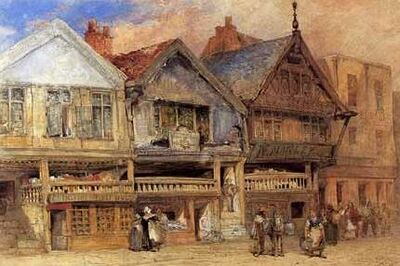
Number #25
Number 25, formerly the Woolpack Inn has a long narrow cellar undercroft of sandstone is which is largely medieval, but may have Roman, or reused Roman, stones immediately above the bedrock at the east end of the north wall, the Row and upper storeys were rebuilt, probably in 1903, by John Douglas.
Number #27
Niches above the capitals on Number #27 contain carved figures, three of these are in Elizabethan costume playing instruments, one with hands removed and the two above the corner post holding scrolls inscribed, (presumably with reference to the effigy of Edward VII above), "THE KING HIMSELF IS SERVED BY THE FIELD" and "THE PROFIT OF THE EARTH IS FOR ALL". This is a quote from Ecclesiastes 5:9, but exactly why this was chosen is a mystery: one commentary states that it means "Even the king milks the land for his own profit!". Moreover, the tradition of men not buttoning the bottom button of waistcoats is said to be linked to Edward, who supposedly left his undone because of his large girth. His waist measured 48 inches (122 cm) shortly before his coronation in 1902 - the same year that John Douglas re-did this frontage.
Number 29 also bears the Chester City motto from the Arms of Chester "ANTIQUI COLANT ANTIQUUM DIERUM" (The elders worship the Ancient of Days), "as granted by William Flower Esq Norroy Principal Herald and King of Arms of the North of England - 22nd Elizabeth 1580 and confirmed by Richard St George Esq Norroy King of Arms in his Visitation 1613".
Number #31
The Dublin Packet (Number #31) facing Town Hall Square is probably early C19, but altered, the frontages to Northgate Street were rebuilt 1902 by John Douglas.
Somewhere in this Row we also have to fit in the "Eagle and Child" between 1540 and 1721. This was the tavern at which the last Minstrel Court was held. The last Minstrel Court was held in 1756, but it is not known whether the Court moved with the tavern (to Foregate Street) or stayed in the "Leg's of Mann" which appears to have occupied the site of the Eagle and Child after 1721, until 1782 - when the Legs of Mann moved to the later site of the Commercial Newsrooms. It looks like the Legs of Mann survived the Commercial Newsrooms, by moving yet again, as it's sign can still be seen in drawings from the 1840's.
Links
- Shoemakers Row on Wikipedia;
Broken Shin Row
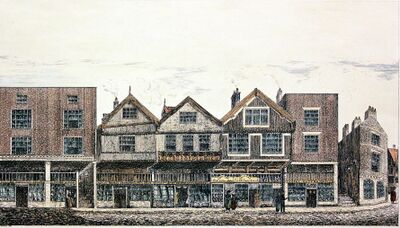
This is the Row opposite Shoemakers Row. Thomas Hughes (1858) describes it as follows, possibly referring to the two Batenham engravings reproduced on the left:
- This view is a direct continuation northwards from the one just described. In grotesque, though, it must be confessed, not appropriate fashion the new here obtrudes itself upon the old, as if determined to jostle it right out of existence: and the threat implied has in the present day been amply fulfilled, for the old buildings here portrayed have all passed away, and been replaced by newer but, alas! we must add much less interesting structures. This picture well exemplifies the process by which many of those ancient rows which at one time lined our Chester streets, have been utterly obliterated to serve personal greed and advantage, the two "broken shin row" and a very" apropos" name it was in our childhood`s days, when we were accustomed to play in it, to the imminent risk of precious young limbs aforetime, it had been a public thoroughfare, running, like its opposite neighbour, Shoemakers row over the cellar shops below, and continuing south wards in front of the tall ungainly new building next door, and so beneath the over hanging gables adjoining, until it united itself, by steps with the other row described in the preceding article. The whole of the four main streets of the city were, as we have just stated adorned with similar rows, and must, two centuries ago have abounded in picturesque outline and detail, highly attractive to the wondering traveler by stage wagon, packhorse or flying machine, at that time, and long after the only means of transit from place to place.
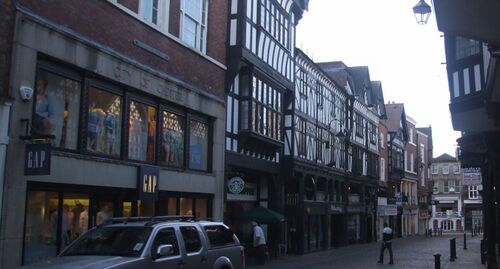
Hughes' reference to a "flying machine" is seemingly anachronistic, the powered aircraft only having first flown in 1904. However, the term is much older, referring both to propeller-driven balloons and even earlier to mechanisms by which actors might appear to fly in a specially rigged theater. Also in 1761 the Chester Courant reported that, from the White Lion (a coaching inn, on or near the site of the Town Hall):
- the Chester Flying Machine, on steel springs, goes thrice a week to London in two days carrying four passengers.
Batenham (1827) also describes it using the term "grotesque":
- The remainder of this street has nothing very remarkable with the exception of a few old houses on the left near the bottom embellished with antique carvings mouldings and grotesque ornaments. The row on this side is not at all frequented as a thoroughfare and is rather low and dark and consequently very private .
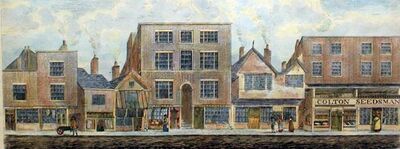
This is still an "unfrequented" part of The Rows. Numbers 4-8 are all brick buildings dating from around 1810-30 and the interiors were extensively remodeled during the "Dark Row Project" (1003-05). Number 4 has a twisted baluster staircase from around 1700, and still looks much as it did in Batenham's drawing from c1816, which also shows that 6-8 each replaced a seventeenth century timber framed building. Number 10 is an early nineteenth century brick building, and while the English Heritage listing records a C19 fascia-board painted "CHEESE:ESTABLISHED 1740:FACTOR" there is no sign of this today. Number (12-14) is a Vernacular revival brick building with a half timbered facade, erected in 1912-13 by R. W. Boden for Walker and Knight. Work at the rear of this and Number 16 in the 1930's revealed a Roman hypocaust, likely to have belonged to the Praetorium, but demolished an under-croft. The narrow alleyway off Northgate Street here goes by the name of "Leen Lane", and probably marks the northernmost boundary of the Praetorium. Northgate Row East ends at this point.
Numbers 18-20 was rebuilt in 1936 for the Chester United Gas Company.
Numbers 22-24 has two medieval undercrofts. These appear to have been originally shorter, but were at some point extended to encroach on the street, probably when the Row were built hereabouts. There is no sign of the Row in this building today. The original building was altered C18 and later and became a town house which was rebuilt probably C18 and c1840. Up to 1924 the frontage to Northgate Street was similar in form to Nos 44 & 46, Nos 48 & 50 and Nos 54 & 56 Watergate Street (qv) with steps to the former Row level in a tall recessed porch; the porch was taken out in 1924 or 1930, but the face to the upper two storeys is probably early C19, as shown in the engraving by Batenham, c1820. This type of porch may indicate that a row had once been present. It was converted to electricity showrooms and offices 1924 by P. H. Lawson for Chester City Council and enlarged in 1930 by F. C. Saxon. The facade of the lower two storeys is a rare survival of the front of an inter-war municipal electricity showroom and is inscribed CITY OF CHESTER in raised Roman capitals.
- Number 10;
- Rosies (12-14);
- Number 16; 10 sandstone hypocaust pillars stand in situ at the north-east corner of the shop.
- Numbers 18-20;
- Numbers 22-24;
- Numbers 26-28 The shops replaced 2 low 2-storey buildings shown c1820 on Batenham's engraving.
Music Hall Passage
Louise Rayers's "The Dark Row" is often said to be "Pepper Row" in Eastgate Row North, which enjoyed a poor reputation and was the home to "The Boot Inn". However, it may be that the painting shows Music Hall Passage - although the placement of the lamp and the general resemblance could be a co-incidence, it seems the best fit in Chester.
Numbers 32-34 form an entry from Northgate Street to the building which was originally the Chapel of St Nicholas, built c1300 for Simon de Albo, abbot of St Werburgh's, Chester. It was used for a period as the church of the parish of St Oswald, then closed as a church and conveyed to the Mayor and Assembly of Chester 1488. It was altered, with an upper floor inserted around 1545, and used as the Commonhall and Wool Hall. The building was used for staging plays from c1750, converted as the New Theatre 1773 and the Theatre Royal 1777-8, being converted as a hall for concerts and entertainments by James Harrison as the Music Hall 1854-5. St Nicholas was used as a cinema mid C20, before being converted to a supermarket, after which it has been used as shops.
Batenham (1827) writes:
- A few paces below this we arrive at the Theater which from its very secluded situation requires a close examination to discover. It's entrance is nearly opposite the fish shambles by a common kind of gate way having the words "Theater Royal" above "to direct enquiring eyes". The history of this being somewhat remarkable deserves insertion for it has undergone many changes as perverse as they are curious. It was built by the monks of St Werburgh as a chapel for the use of the parishioners and dedicated to St Nicholas themselves wishing to keep an undivided possession of the cathedral in which the parish church was situated but some time after the people returned to their old place of worship and the chapel was sold to the corporation who fitted it up as a common hall they however having better accommodated themselves it was again disposed of the ground floor became a waggoner's warehouse and the other part has been appropriated to its present use. The performers resort hither during part of the winter season and in the race week and the house is occasionally let for an exhibition a lecture or any other purpose of entertainment that may he required.
Seacome (1828) adds a little more detail about the differences between the theater and the Corporation:
- The Chester Theatre was erected by a Company of Proprietors in 1773 on the site of St Nicolas Chapel Northgate street and opened the same year under the management of Messrs Austin and Heaton. But in 1777 the Mayor thought proper to issue an edict against the further continuance of dramatic performances therein and this too at a period when bullbaiting was annually practised at the Cross in presence and under the patronage of the Corporation. In this emergency the proprietors were necessitated to call to their aid the power of the crown and they obtained a patent dated 16th May 1777 in the name of J Townshend Esq constituting their theatre a Theatre Royal. The Theatre as originally fitted up was calculated to contain about 100 but Mr Lewis the Lessee of the Liverpool Theatre took a lease of it in the Spring of 1828 and by raising the ceiling obtained room for an additional tier of boxes by which and other enlargements the house is now capable of containing 170 and is altogether one of the most elegant and commodious of any out of the Metropolis. The proscenium of the theatre is supported by six white fluted pilasters with fillets of burnished gold and Corinthian capitals in burnished and dead gold having a vaulted front ornamented with the royal arms with lemon coloured pannels and scroll gold omameuts. The stage doors are ornamented with gold heading and the side wings and scenery are of a description very superior to what is usually displayed in provincial theatres. The ceiling has an octagonal sky coloured cove in the centre with lemon coloured corner pannels. The fronts of the boxes are white and lemon-colonred divided into pannels by gold heading and the pillars which support the upper tiers are white with crimson pillasters and gold beading. The present prices of admission to the different parts of the house are Boxes 4s Pit 25 6d Gallery 1s.
Hughes (1858) is his usual effusive self:
- ..let us proceed a little further in order to examine yonder stately looking pile only just completed to wit the New Music Hall. Perhaps no structure within the city has undergone greater or more numerous changes of character than the shell of the one we are now surveying. The first we hear of it is as the Chapel of St Nicholas built it is supposed early in the fourteenth century. About this time we read that the monks of St Werburgh (monks were greedy dogs!) wishing to have the whole Cathedral to themselves transferred the parish Church of St Oswald then as now occupying the south transept of the Cathedral to this Chapel of St Nicholas which latter had perhaps been built with that idea looming in the future. But the parishioners and corporation repudiated the change and after much litigation recovered then old parish Church so the chapel of St Nicholas was speedily deserted After being to let for some fifty or sixty years we next hear of it as the Common Hall of the city removed here from Common hall Street in 1545 In this service it remained the arena of law if not of justice for the two do not always go hand in hand until 1698 when the magisterial chair was removed to its present resting place in the Exchange. The third phase in its existence was its conversion into the warehouse of a common carrier and into a mart for the sale of wool the name it then bore was the Wool Hall. Again was St Nicholas the victim of transformation for at least as early as the year 1727 the walls which once echoed forth the sounds of prayer and praise were made to ring with the ribald jests of a common playhouse. Thirty years afterwards there were two Theatres open at one time in Chester one here and the other at the Tennis Court in Foregate Street but about 1768 the latter establishment was closed up and its "galaxy of talent" transferred to the Wool Hall. In 1777 the necessary patent from the crown was obtained for the licensing of the premises and the Wool Hall forthwith developed into a Theatre Royal. We will not stay to run over the numerous stars which have from time to time graced this theatrical firmament it is enough to know that this light of other days has faded away and that so far as this building is concerned the Chester Theatre exists only as matter of history.
Hughes (1858) continues:
- In 1864-5 the Theatre was wholly obliterated and the building in great part taken down but the massive buttresses and sidelight arches of the original ecclesiastical structure were suffered to remain and are yet plainly visible upon the north and south sides of the building. And now comes the last scene of the drama the scene we are now contemplating. On the ruins of the fallen Theatre and on the foundation walls of the ancient Chapel of St Nicholas modern enterprise has raised a pile more in unison with its first estate and far more worthy its close proximity to the Cathedral the New Music Hall. The Hall has been erected from the designs of Mr James Harrison architect whose other important works about the city we have already noticed. Its peculiar position beset with heavy private buildings on three of its sides prevented much attention being paid to the exterior but the east front being comparatively free has afforded Mr Harrison an opportunity for displaying his professional skill. Seen from the other end of St Werburgh's Place the handsome Tudor windows and porch of this front have a rich and truly picturesque effect our artist however has chosen a nearer view in order to give strength and definition to his sketch. In addition to a refreshment room ladies waiting and retiring rooms and other offices the interior presents to us a large and noble hall 108 feet long 40 feet wide and 60 feet high capable with its two handsome galleries of accommodating an audience of 1400 people. Its spacious orchestra adorned with an organ of superior excellence by Jackson has ample room for 250 performers. The neatly panelled roof resting upon shafted cross beams tastefully ornamented gives to the Chester Music Hall a richness and elegance wholly unapproached by any similar room in the city. The Hall is in every respect a credit alike to the architect and to the city and it is not too much to add that Mr J. D. Williams the builder and decorator of the structure has done his part of the work faithfully and well. One man only was killed during the progress of the works by an accidental fall from the ceiling of the Hall. It was opened Nov 26 1855 with a grand concert at which Clara Novello and others officiated.
The Theatre Royal was managed as part of a circuit which included Newcastle, Lancaster, Whitehaven, and Preston. The programmes included Shakespeare, Garrick, Sheridan, and Otway, new comedies and farces, and pantomime, and all the leading actors of the day trod its boards between the 1780s and the 1820s, among them Edmund Keen, Sarah Siddons, and Joseph Grimaldi. Charles Dickens gave a talk here on January 22, 1867 (he stayed at the Queen Hotel)and later described Chester and the Theatre Royal as follows:
- “I have seldom seen a place look more hopelessly frozen-up than this place does. The hall is like a Methodist chapel in low spirits, and with a cold in its head. A few blue people ahiver at the conners of the streets. And this house, which is outside the town, looks like an ornament on an immense twelfth cake baked for 1847”
Dickens was both exhausted and unwell at the time, afflicted by gout, Erysipelas, neuralgia, cardiac symptoms, and bleeding piles. His feet so swollen that he could not walk unaided for some weeks. To add insult to injury, the takings in Chester were worst of any of his tours.
Many other famous names gave lectures, including explorer Roald Amundsen and Winston Churchill, who spoke on the Boer War in 1901. Films were shown from the early part of the 20th century and from 1915 it was known as Music Hall Pictures. Chester Music Hall Ltd reconstructed the hall and ran the 820-seat cinema from 1921. The first film was Charles Chaplin’s "The Kid" and Chester’s first ‘talkie’ was "The Singing Fool" starring Al Jolson in 1929. The cinema closed in 1961. At present St Nicholas is occupied by "Superdrug", and the frontage on Northgate Steet is clearly dated 1993. The back of the shop is where Harrisons work can be best seen. For conversion to the Music Hall, Harrison added the canted east porch with central doorway and a square-headed window of 2 trefoil-headed lights in each oblique face; hoodmoulds and a moulded string-course carried up over the door and window opening. Harrison inserted 2 windows similar to those in the porch in the east wall of the chancel above, and at a higher level a mullioned and transomed 3-light window. The visible mediaeval fabric (probably of 1488) is on the south side, in Music Hall Passage.
- Number 32-34 Northgate Street;
- St Nicholas on English Heritage;
- St Nicholas on Wikipedia;
- The Theatres Trust gives a useful history;
The Town Hall/Market Square
"Town Hall Square" or "Market Square"? - Cestrians will refer to both the Market Square and the Town Hall Square when discusssing the space in front of the Town Hall. The 1875 OS map labels this space the Market Square, and at that time it housed the meat market in a building which occupied the space in front of the Town Hall.

Seacome describes the market as follows:
- The state of the markets was until very lately highly discreditable to the city of Chester The meat market consisted of a collection of covered wooden stalls crowded together on the north of the Exchange and universally kept in a very filthy condition and a similar nuisance on the south side of the Exchange served for a fish market whilst vegetables fruits and flowers were scattered in complete confusion throughout the piazza and along the front of the building.
The Exchange
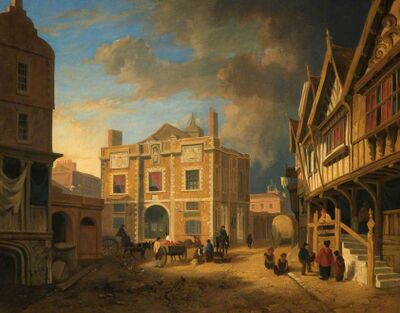
The Exchange, known at first as the "new common hall", was erected between 1695 and 1698 at the corporation's expense but with contributions from William III, Peter Shakerley (former governor of the castle and a Tory M.P. for Chester from 1698), Francis Gell (projector of a plan to improve the River Dee navigation), and the estate of Thomas Cowper of Overleigh Hall. It stood south of the site of the "Shambles" in the wide middle section of Northgate Street almost opposite the Cathedral. The building, of brick with stone quoins and elevated on pillars, was adorned in 1712 with a life-sized statue of Queen Anne (6 February 1665 – 1 August 1714) 'curiously gilt and painted' placed over the main entrance in the south front. The lower storey formed an open piazza with a coffee house, initially in the south-west corner, but later moved to the north-east corner. The main apartments were in the upper storey, which comprised 'a fine magnificent room styled the common hall of pleas', with to the south the portmote court, 'extremely ornamental, wainscotted with oak and adorned with figures of carved work', and to the north the sheriffs' court. Those apartments later functioned as an assembly or banqueting room, a court room, and a council chamber.
Celia Fiennes is the only writer to describe how the coupola on the roof of the Exchange had windows which gave a spectacular view of Chester:
- The Cathedrall is Large and Lofty, ye quire well Carv'd, fine tapistry hangings at ye alter, a good organ: The Bishops pallace is on the Right hand of it and the Doctors houses, all built of Stone. There is a new hall building wch is for ye assize and it stands on great Stone pillars wch is to be ye exchange wch will be very Convenient and handsome; the hall is round, its built of Bricke and Stone Coynes, there are Leads all round wth battlements and in the middle is a tower, there are ballconies on ye Side and windows quite round ye Cupillow that shews ye whole town round. There is another town hall-a long Lofty place, and another by the Side wch is Called the Councill Roome both for ye Major and Aldermen to meete for ye buissinesse of ye Corporation.
The first home of the Chester Savings Bank was in the Exchange. By the middle of the 19th century, business had grown to the extent that the Bank needed its own self-contained offices in Grosvenor Street in 1853.
From the very beginning, the Exchange has seen some turmoil over the years. Cooke writes:
- "In the year 1698 the citizens were convened, and, by some artful means, persuaded to elect the whole body, and then to vote that they should continue in their offices, according to ancient custom. Thus was entirely destroyed the ancient privilege of annual elections in the corporation."
Of the approach of the elections of 1732, Cooke writes:
- "It was apprehended that the corporation, having the power of making freemen in their own hands, might procure as many votes as they wanted. Some of the aldermen, having assembled together in the Pentice, at a late hour, on the Tuesday night preceding the election, suspicion arose that the whole night was to be employed in admitting to the freedom of the city as many of their party as they could conveniently introduce. A mob presently assembled about the Pentice, where they broke open the door, assaulted and drove out the aldermen, and damaged considerably the windows and furniture."
The following day:
- "a large body of colliers, and other countrymen, were brought from the neighbourhood of Wrexham, by the direction and under the influence of Mr. W. W. Wynne (the "leading squire of North Wales"). The citizens hearing of their approach, retired into the castle, and there armed themselves with old swords, helmets, and breast-pieces; and, thus formidably accoutered, sallied forth to meet their foes. A bloody encounter ensued in Bridge-street; and the Welshmen, after several of them were dangerously wounded, were soon routed and put to flight".
The election occurred and, as Cooke continues:
- "no sooner were the books closed, and the mayor and his attendants retired from the hustings, than they were obliged to retreat into the Exchange Coffee-house. They were, however, not here secure, for the mob broke in, seized the sword and mace, and, chairing their favourite candidate, bore him to his house in triumph."

In 1756 the Exchange, which had already been strengthened by the addition of 'several strong pillars', was showing signs of collapse. It was secured by enclosing the ground floor to house the row of shops, on which work continued until 1759, and in 1801–2 was further adapted to plans by Thomas Harrison to provide for the court rooms and offices formerly in the Pentice.
Batenham (1827) describes it as follows:
- "The Exchange is the large handsome building .. supported in the centre by a range of pillars and by a few shops on the west side which were unfortunately obliged to be put there to strengthen it it is in length about 126 feet in breadth about 46 and was erected in the year 1698. In it are contained the Town Hall, a large Assembly room, the Mayor s office and others. The exterior is finished with stone facings angles and cornices and surmounted with a neat cupola and has a fine statue over the south entrance of her Majesty Queen Anne besides which in two large panels are carved the arms of the Earldom and that of the kingdom before the Hanoverian quartering. The whole of this fine sculpture was unfortunately much injured during the election contests of 1784 and 1812."
Hughes (1858) writes:
- "But what is yon new looking structure overlooking the Marketplace? New did you say? Why it is not very far from a couple of hundred years since that building, the Exchange, first delighted the eyes of the old fashioned citizens. True the stone work has been lately restored and the bricks newly pointed but practically this is the same Exchange which in 1698 was completed at a cost of £1000, Roger Whitley the then Mayor being a large contributor. The statue embellishing yonder niche on the south front is a graceful representation of Queen Anne of glorious memory in her coronation robes, a work which must have emanated from no mean chisel. The superstructure of the Exchange stood originally upon four rows of stone columns the ground floor being otherwise entirely open but in 1756 just a hundred years ago owing to some well grounded fears for the safety of the structure the lower tiers of shops etc. were erected as an extra support to the fabric the greater portion of these are now occupied as police offices, lock-ups etc. On the higher story are the Assembly Room the Penitice or Council Chamber and the spacious Town Hall. The Assembly Boom was a popular resort in the last generation when corporation feasts redolent of venison and primest turtle were perpetually being discussed there but its many a long day since these savoury viands graced the aldermanic board."
As the Exchange was known to be in disrepair by 1839, the building must have been renovated so that Hughes could see it "as new" in 1858 (the Corporation borrowed £800 in 1856 for repairs to the Exchange). However, it was destroyed by fire just a few years later on 30th December 1862. But it did last long enough to appear in McGahey's "View from a balloon" as shown in some of the preparatory sketches for the view (see above left).
Most of the important contents including the city records and all except two large paintings were, however, saved. The ruins of the Exchange were cleared after the fire and its site was taken into an enlarged Northgate Street. Until the new Town Hall opened on an adjoining site in 1869 the council met in the Chester Savings Bank in Grosvenor Street and its staff were housed in premises in Lower Bridge Street. The statue of Queen Anne was removed to Bonewaldesthornes Tower, where it is further discussed (see: "what happened to Queen Anne?"). The coats of arms from the Exchange were also taken to Bonewaldesthornes Tower, and are still there, on the spur wall leading to the Watertower.
It has been said that one of the pillars from the Exchange now stands in the center of the Abbey Square. Hemingway (1831) tells the story as follows:
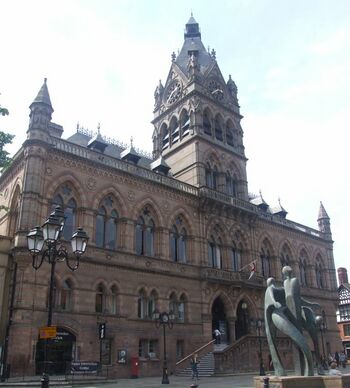
- "In 1766 it was discovered that all the west side of the Exchange had given way and was likely to fall Mr Turner an architect was sent for from Whitchurch to survey it. In consequence the row of large stone pillars was removed from the centre more towards the east side and a row of shops built along the west side. In removing these pillars one of which stood at the corner of Mr Broster's shop now Mr Pover's was broken off at the top and the corporation made a present of it to the dean and chapter to make an obelisk to be erected in the centre of the Abbey square where it now stands."
As Hemingway is writing well before the Exchange was burnt down it seems that the alternative version - that the pillar came from the burned-out Exchange cannot be true.
- Hanshall gives a detailed description of the Exchange on pages 267-268 of The history of the county palatine of Chester;
The "Town Hall" Side
Hughes is less than impressed by the Market Square of his day:
- ..we are once more in Northgate Street and may stay to give "one withering glance" at those melancholy looking buildings either side: the Fowl, Butter and Butchers Markets of the city. Hideous as specimens of architectural taste, destitute of convenience or comfort in use, furthermore heavy and cheerless to look upon these Markets have of themselves nothing to rivet the attention of the sightseer.
Markets
Fortunately, in 1863, a new Market Hall was built, and the "Town Hall side" of the market square used to be dominated by the baroque-revival frontage of Chester's "traditional" Market Hall. From the 1860s, ever-larger sums were borrowed for capital works. The biggest items were £11,000 in 1863 for the Market Hall, £35,000 in 1867 and 1870 for a new Town Hall after the Exchange was destroyed by fire (the balance of the cost coming from insurance), and £50,000 over the period 1873-9 for sewerage works. Even the smaller amounts spent on buying up property for extending the markets were large by earlier standards, so that by the time of the 1884 Improvement Act the council had raised a little over £120,000 in loans. Of £101,000 outstanding in 1878-9, the main source was public works loans, accounting for 46 per cent; private individuals had advanced 30 per cent, the governors of the Chester infirmary 11 per cent, and the trustees of the Owen Jones charity 10 per cent.
Prior to the building of the Market Hall being a stall-holder in Chester was fairly unpleasant, as described by Hemingway:
- For several years complaints against this inconvenience had been general both among buyers sellers; the latter suffered in an extreme degree as they were destined not unfrequently to stand for six or hours up to the ankles in mud, and sustain besides the 'peltings of the pitiless storm' before they could dispose of their wares.
The Market Hall was an airy building with a high (and waterproof!) glass roof supported on iron pillars and sheltering traditional "stalls". Unfortunately this was demolished in the 1960's to be replaced with the first version of "The Forum" - a particularly ugly shopping center with the new market hall tucked away at the back. The latest version of "The Forum" (1995) is barely better, and is itself planned for redevelopment. The only remaining part of the Victorian Market Hall frontage is a small portion of stonework in the corner of the Market Square by the DubLin Packet. However a much larger chunk, including the inscribed "foundation stone" survives in Princess Street.
Roman Strong Room
A trip under the arch that remains of the Market Hall leads to the "Roman strong-room". Chester’s Roman strong-room was excavated by archaeologists during the late 60s (when the Market Hall was being demolished around them) and would originally have been under the rear part of the "Principia".

Town Hall
The Town Hall: of which more can be discovered on the Town Hall page, was opened for public use in 1869, on October 15th by the Prince of Wales - later King Edward VIII. The Architects were Messers Lanyon, Lynn, and Lanyon of Belfast. As the original contractor, Mr Clark, died, work was suspended until arrangements were made with Mr. Hughes, builder of Aldford, to carry out the contract. The tower is 160 feet high. The ground floor was mainly occupied by the Police Offices, from which corridors run to a range of prison cells, kitchens, and other offices, Above these are the Public Hall, the Magistrate Court (the courtroom ceased to be used for Quarter Sessions in 1972 or as a Magistrates Court in 1991 when a new Magistrates Courthouse was opened in Grosvenor Street). The Town Hall is still used by officers, but today. most locally based Council departments are housed in the adjacent Forum, which was opened in 1973. However, the Town Hall is still regarded as the symbolic expression of civic government, having changed very little in external appearance since 1869.
On 21 June 1889, William Freize-Green was issued patent no. 10131 for his 'chronophotographic' camera (“An Improved Apparatus for taking Photographs in Rapid Series”). It was apparently capable of taking up to ten photographs per second using perforated celluloid film. He was the first to use celluloid. A report on the camera was published in the British Photographic News on 28 February 1890. On 18 March, Friese-Greene sent a clipping of the story to Thomas Edison, whose laboratory had been developing a motion picture system known as the Kinetoscope. The report was reprinted in Scientific American on 19 April. Friese-Greene would later claim that one Sunday morning in January 1889, he set up his newly-invented camera – a box approximately one foot square with a side-handle – on a tripod to the west of Aspley Gate in London’s Hyde Park and exposed roughly 20 feet of film. Friese-Greene claimed to have filmed “leisurely pedestrians, open-topped buses and hansom cabs with trotting horses” According to some sources, it was first publicly exhibited at Chester Town Hall 1890. Thus, William Freize-Green claimed to have shown the first ever successful moving pictures on 26 June 1890 at Chester Town Hall, during the 1890 "Chester Photographic Convention". That would make the Town Hall the world's first ever cinema. Unfortunately, there is no surviving record of the actual demonstration and the claim has been dismissed as either self-deluding or fraudulent. Beset by financial troubles (including a spell in prison for borrowing money while an undischarged bankrupt), Friese-Greene remained an incorrigible optimist. Although he was forced to sell the rights to his patent for £500 (the first renewal fee was never paid and the patent lapsed in 1894). He died penniless on 5 May 1921 while giving an incoherent speech to a meeting considering the parlous state of the British film industry - which attempted amends with his tombstone inscription and a lavish funeral wreath - a floral projector and screen with blooms spelling out 'The End'.
Princess Street
In 1914 most working-class Cestrians lived in 19thcentury terraced housing with tiny back sculleries, outside lavatories, small back yards, and front doors opening on to the street. In the city centre, conditions in the courts of Princess Street, Goss Street, and Crook Street remained below that standard into the 1930s. In Princess Street (which the Town Hall stood on the corner of) there were 224 houses, of which 140 were damp and 120 verminous; 103 shared lavatories, 118 had no suitable washing accommodation, and 108 lacked a sink or internal water supply.
Coach and Horses (Now Coach House)
Number 39 is listed as the "Coach and Horses", although it is now the "Coach House" and while it is a listed building there is little to comment on. The earliest record of it comes from 1690, when one of the secretaries of the then king (William of Orange) noted that he disliked the food served there. Hughes JAAHS - writes of it:
- "Returning to the head of Parson*s Lane, we find at its northern comer an inn, once of considerable repute, and even yet not without some slight pretence to respectability, denominated in the last century by its present title "The Coach and Horses Inn". Changed are the days since that house was established, the lively stagecoach, then in its infancy, has since attained a somewhat premature old age, and been consigned to "the grave of all the Capulets". In 1721, Robert Crompton, Esq., of the Bache, appears in the Corporation books as the proprietor of the " Coach and Horses, at that time one of the chief inns of the city. At least a hundred years ago, there was a large coaching establishment connected with the house, then tenanted by Charles Rackett, a relative of Alexander Pope, the poet. At that time, too, the principal Cestrian Lodge of the Ancient Order of Freemasons was held at this inn ; and here the brethren of that august Order, headed by Alderman John Page, Grand Master of the district, sat down to a banquet on the 11th of August, 1768, after having laid the foundation-stone of our present Eastgate. In February, 1773, Mr. Astley, of the Amphitheatre, London, accompanied by his son, then five years old, and a portion of his company of equestrians, performed for three days in a large croft behind and attached to the Coach and Horses Inn."
There is an amusing tale of the "Coach and Horses" from the 1990's. During one of the Chester Mystery Plays seasons, the boy playing a rather major part in one of the plays nipped in for a pint during the intermission and (still dressed in white robes) was promptly accosted by the police for under-age drinking. He uttered the startling reply "You can't nick me - I'm Jesus". After a further exchange of words (and the intervention of a few other customers who had taken the same opportunity for a drink in the intermission), he was released and was able to return to the stage for the second half of the play.
An even stranger tale dates fom 1988 - when a sad and gloomy looking old man entered and booked a room for the night. He then went out saying he wanted a walk before retiring. He never returned. Enquiries with the police later revealed that the man who supposedly signed the register, and gave his home address, had in fact died some eight years earlier.
Westminster Coachworks
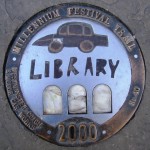
Chester Library: built in 1914 as the Westminster Coach and Motor Works for J.A Lawton & Co to the designs of the architect Philip H. Lockwood; its shiny pickish-buff terracotta was designed and made by Dennis Ruabon. Surprisingly, it is not a listed building. The façade is dated 1914, but appears to be based on an earlier building for the carriage-builders J A Lawton & Co that was burnt down on July 1st 1910 (following an earlier fire in 1903). Their building was two storeys high, but otherwise apparently similar to the existing design. Cars were sold on the site until the 1970s, and a new library was built behind the façade to an award-winning design by the Cheshire County Council Department of Architecture in 1981-4.
The first public library to be set up in Chester was the City Library in Whitefriars in 1773. It had very few novels having mainly erudite tomes on history, geography, law and philosophy. It was situated first in the entrance to Bolland’s Court and then it moved to a room in Fletcher’s buildings, Bridge Street (later used as the offices for the Chester Chronicle). To use the Public Library there was an entrance fee of 10/6d and then an annual subscription of one guinea (the average wage at the time for a general labourer was £44). The Council considered building a library and museum in Northgate Street on land adjacent to the Abbey Gateway, next to the proposed new King’s School. However on financial grounds it decided to buy the St John Street building from the Mechanics' Institute which had run into difficulties. £1,300 secured the building, books and other contents. The Chester Free Public Library opened its doors on 1st January 1877, twenty seven years after the Act which permitted the establishment of a free service. 36,000 books were issued in 1878, but the following year the Chronicle was already commenting on the ‘dingy and uncommodious rooms of the library building…and the unfitness of the building for the purposes of a library.” However it would be another 100 years before anything was done about it. In 1974 there was a Local Government re-organisation and Cheshire County Council gained control of the Library. From 1982 building work began on the new Chester library and in 1984 the new library opened.
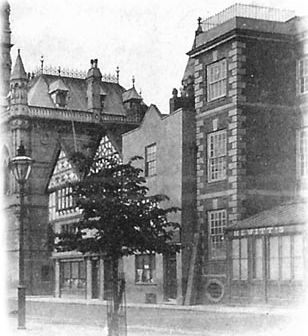
Lawtons factory stood on the site of the house that the Cholmondeley family occupied after leaving their house outside of the walls in Grosvenor Park during the Civil War. Thereafter the house became known as Cholmondeley House. The building originally used by Lawton was constructed as two houses built by William Massie prior to 1723, one of which was sold to Robert Davies of Llanerch. In 1754, Bishop Keene (he of the wealthy wife) occupied it until the new Bishop's Palace was completed. Later it became a school run by the Revd James Winfield, with two famous pupils being Lord Hill and Lord Combermere. It became Hewwitt's Coarchworks in 1874 and then passed to J. A. Lawton, who rebuilt it in 1895.
Shropshire Arms
Outside Number 45, the Shropshire Arms (an unlisted Vernacular Revival public house) are some red phone boxes. These are the famous red "K6" design of Sir Giles Gilbert Scott in 1935. Between 1868 and 1876 his grandfather George Gilbert Scott "almost entirely recased" Chester cathedral. In addition to extensive additions and alterations to the body of the church, Scott remodelled the tower, adding the turrets and crenellations - something which is echoed in his grandson's design for Battersea Power Station.
Much more on the history of the Market can be found at:
- Chester Market;
- Chesterwalls.info - also on the Market;
- Roman strong-room by ChesterTourist;
- Town Hall at English Heritage.
- Number 39
- The phone boxes are listed too!
The "Abbey" side
This East Side of the Market square is a complete contrast to the west. The first buildings on the right are modern and do not fit in at all well, but to some extent this is "saved" by the white stucco building with a tower on the corner, Passing that, the sudden and possibly unexpected view of the west front of the Cathedral is spectacular and much photographed. Like the cathedrals of Carlisle, Lichfield and Worcester, Chester Cathedral is built of New Red Sandstone, in this case, the Keuper Sandstone obtained locally. While the stone lends itself to detailed carving, it is also friable and easily eroded by rain and wind. It is also badly affected by pollution. Chester is one of the most heavily "restored" of England's cathedrals.
Cathedral West Front
The façade of the cathedral is dominated by a large deeply recessed eight-light window in the Perpendicular style, above a recessed doorway set in a screen-like porch designed, probably by Seth and George Derwall, in the early 1500s. The window contains stained glass designed by W. T. Carter Shapland dating from only 1961 and depicts the Holy Family in the middle two lights, flanked by the northern saints Werburgh, Oswald, Aidan, Chad and Wilfrid, and Æthelflæd. Chester suffered badly at the hands of the Parliamentary troops during the Civil War, and, as a consequence, its stained-glass mostly dates from the 19th- and 20th-Centuries.
The porch formed part of a late 15th-century building programme which included the south transept, central and southwest towers, and cloister. Neither of the planed west towers were completed. To the north of the doorway is the lower stage of a Norman tower, while to the south is the lower stage of a tower designed and begun, probably by Seth and George Derwall, in 1508, but left incomplete following the dissolution of the monastery in 1538. The door of the west front is not used as the normal entrance to the cathedral, which is through the southwest porch, which is constructed in an ornate Tudor style. Entrance is at time of writing free, although the Cathedral had caused some controversy in the past by a compulsory entrance charge which started in 2004, this was removed in 2013. In the 1920s, Chester became the first cathedral in England to open its doors to visitors without charge.
Bishop's Palace
The cathedral's façade is abutted on the north by a Victorian building housing the education centre and largely obscured from view by the building previously used as the King's School, which is now a branch of Barclays Bank. The Barclay's Bank building has at various times included the Cathedral Choir School, the Magistrates Court, and the library of Cathedral. It was built c1875. by Arthur Blomfield, and opened as the Kings School in 1876 by Gladstone - the "poor and friendless" pupils of the Kings School having been housed in the former monks refectory for most of the previous 400 years.
Prior to this the site was occupied by the bishops palace constructed by Edmund Keene, Bishop of Chester from 1752–1771 and later Bishop of Ely. The bishop "rather unusually met the cost out of his own pocket" - but he could afford to, in May 1753 he had married Mary, only daughter and heiress of Lancelot Andrews of Edmonton, formerly a linen-draper in Cheapside, and with her received a large fortune. The Bishops palace is shown on the Lavaux map and can be seen in the detail above which also shows The Exchange.
The Elephant
Just on the corner is the incredibly lifelike sculpture of Janya the Indian elephant, it was a gift from Chester Zoo to the people of Chester and named after the people of Chester selected the name from a shortlist ("Janja" means "life" in Hindi). The bronze elephant is a 2010 work of the Hampshire-based sculptress Annette Yarrow who grew up in India in the 1930's and 40's, and so had much first-hand experience of real elephants. The bronze took six months to complete. Nearby, inside the Cathedral there is a 14th century carving of an elephant and it is fairly obvious that the medieval craftsman had not seen a real elephant, as this one has hooves. Some people mistakenly think that this bronze statue is of an actual elephant from the Zoo, and perhaps confuse it with the actual elephants Nayan Hi Way (born 2010, and sadly, died in 2013) or Jamilah Hi Way (born 2011, and who also sadly died in 2013).
The Engine House
Where the elephant stands was once the location of "The Engine House", which Hanshall describes as follows:
- "THE ENGINE HOUSE This is a neat building opposite the east side of the Exchange. It was erected about the year 1680 by the Duke of Ormond when Lord Lieutenant of Ireland but why this mark of respect to the City was manifested remains a secret. It is built of brick with stone facings ornamented with fluted Corinthian pilasters. An iron railing was placed round it in 1812 and the brick work coated with Roman cement. The Fire Engines are kept here and the City weights measures etc."
Broster provides similar information:
- "THE ENGINE HOUSE near the Exchange is a neat building with fluted columns and a rich cornice of the Corinthian order and was built at the expence of the Duke of Ormond, Lord Lieutlenam of Ireland. The fire engines are kept here at the expence of the Corporation, and they keys by persons in different parts of the city. On the east side of the Exchange stands the Bishop's palace and the Cathedral. The three flesh shambles (where the country butchers are allowed to sell their meat upon market days) fill up a great part of the street; upon one of which, is placed a large cistern or reservoir of water conveyed there by pipes from the water-works at the bridge which supplies the inhabitants of the upper parts of the street with water."

James Butler, 1st Duke of Ormonde, was Lord Lieutenant of Ireland from 1677 to 1685. Prior to that he had been commander-in-chief of the forces of Charles I in Ireland. In November 1643, by the king's orders, Ormonde despatched a body of his troops into England to fight on the Royalist side in the Civil War, estimated at 4,000 troops, half of whom were sent from Cork. Ormonde sent over a further body of 1300 foot and 130 horse in December. Thomas Carte in his History of the life of James Duke of Ormonde writes:
- The Marquis of Ormonde on Dec 3 sent over another party of 1300 foot and 140 horse under Colonel Robert Byron who, landing at Chester, and Lord Byron coming thither at the same time with a body of 1000 horse and 300 foot to take on him the command of the forces in those parts, they were all drawn out into the field notwithstanding the severity of the season which it was thought they were fitted to bear by the hardships to which they had been inured in Ireland. Lord Byron marched out of Chester on the 12th with 400 foot and 1000 horse took Beeston Castle, Crewe House, and drove Brereton from Sandbach and on St Stephen's day routed him at Middlewich, where he was strongly posted.
Thus, Ormonde, sending troops to Chester in such numbers, set the scene for the destructive siege of Chester, perhaps later in life he felt guilty and thought some fire-engines would be a good gesture. The location later became the poultry market, as Hemingway writes:
Abbey Gateway
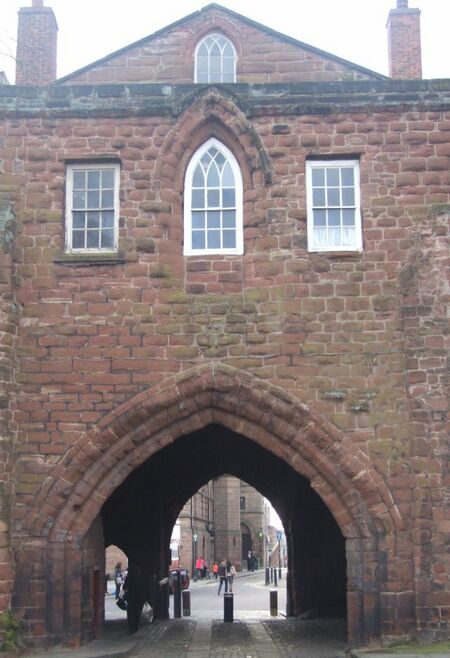
- Crossing a narrow avenue from the north end of the Exchange and we enter through an iron grated door the market house appropriated for the sale of butter on the market days in which also is a similar door in the centre of each side. Six or eight yards apart from this in a direct line is another building of equal breadth but longer for butcher's meat both of which are neatly fitted up for their respective purposes and are well ventilated by a number of half circular openings at the upper sides of the walls these are built of brick pointed with stone roofed in and lighted from the top. The market for poultry is on the east side of the street opposite the Exchange occupying the site of the old Engine house. Its back is formed by the outward wall of the Bishop's Palace from whence a slated penthouse descends in an oblique direction nearly as far as the walking path in the street for the purpose of shelter and along the front is a neat iron pallisading. The width of the area within is about six yards and in length it reaches from the end of Werburgh street to the Abbey gate.
The Abbey Gateway: c1300. The front room above the arch, evidently formerly a robing room, has ranges of cupboards with fielded panels to doors, built against 2 walls; the panel to the upper cupboard above the doorway has an armorial painting inscribed EDMUND CHESTER; the armorial panel immediately north of the doorway is inscribed SAMUEL PEPLOE LLB, Chancellor. The painter was probably of the Randle Holmes family. For more on the Chaancellor see Peploe. Virtual Chester has a panoramic view. Hemingway describes the gate as follows:
- Over against the market halls on the east side of the street stands the Abbey gate consisting of a lofty pointed arch with a postern at the side both of which are included in a larger obtuse one The interior of the gateway is vaulted with stone with ribs and carved keystones at the intersections and the rooms over now used as the registry were originally approached by a spiral stair case On the south side was the porter's lodge and on the other St Thomas's Court to which the tenants of several abbey manors still render suit and service Before this gate were anciently ranged the booths for the merchants frequenting the abbot's fair covered with reeds which the monks were empowered by an especial charter to gather from Stanlaw Marsh and here also the performers in the Chester mysteries commenced the exhibition of their pageants.
During the Civil War, the Royalist Sir Timothy Fetherstonhaugh liberally contributed money to the royal cause, raised troops at his own expense, and served in the field. At the Battle of Wigan Lane, Lancashire, 26 August 1651, he was taken prisoner, and imprisoned at Chester Castle (more information on Sir Timothy Fetherstonhaugh can be found on the Castle page). Following trial by court-martial at Chester for "corresponding with Charles Stuart or his Party", he was beheaded outside the Abbey Gate, 22 October 1651, despite his plea that he had "quarter for life given him".
- Abbey Gateway on Virtual Stroll;
Abbey Square
Abbey Square is the best quadrangle of Georgian houses in Chester, with a pair of earlier, more modest, 17th century dwellings and the access down a short flight of steps to the cloisters and refectory. The two Georgian terraces were built by clergymen, often well-to-do in those days, for Cathedral clergy. The square's layout is not in fact a rectangle, as it tapers quite sharply to the south. This lengthens the apparent perspective toward the Cathedral, but shortens it to the north so that the terrace looks closer (the trees on the central lawn tend to conceal the illusion, particularly in summer). As noted above, the shaft of the crossis reputed previously to have been a column of The Exchange. However, it does not look like the "Exchange" columns as depicted by artists and as evidenced by the (probably) surviving column from the Exchange which stands in Northgate Street among a collection of Roman stones (for which it was mistaken).
Hemingway describes Abbey Square as follows:
- On passing through the arched gate way we enter into Abbey square. On the right hand is a dead wall inclosing the episcopal palace a good stone building but as destitute of magnificence as it is of elegance. This edifice was wholly rebuilt by Bishop Keene out of his private property at an expence of £2200 soon after his promotion to the see in 1752. The east side of the square contains only two good houses one at each extremity the interval being occupied by smaller dwellings. The north and west sides are filled up with elegant buildings occupied by some of our first quality. The two end houses adjoining the gate stand on the site of an old edifice called the prison house On pulling down the latter about five years ago a narrow cell was discovered on the first floor from which all light was excluded in which it is said that martyr to popish cruelty, George Marsh, was immured previous to his execution at Boughton.
George Marsh definitely does not seem to have had a pleasant time while in Tudor Chester, but it seems that he was also imprisoned at the Northgate as well as here (which was even more cruel). However, the cellars of the 1771 town house at 3 Abbey Square lead down to an even lower cellar under the pavement of Abbey Square itself (which has coursed sandstone walls beneath a probably C18 segmental barrel vault of brick), and is reputedly the ecclesiastic court cell.
Just past the Abbey Gateway Numbers 54 and 56 have shopfronts of c1900 with wood frames, leaded glazing above the transom bears the City Arms of Durham, Salisbury, Newcastle, London, Chester, Carlisle and York. The pargeted panels beneath the third storey windows to the street are inscribed ANNO DOM:MDCCCC. This is 1900 but the use of four consequtive "C"'s in Roman numerals is incorrect, and it should be written MCM. While these two town houses are dated C17 and early C18, they possibly comprise earlier elements - the cellars to both former houses have walls of bedrock and sandstone, with some brickwork, the party wall between the former houses is 18 inches thick. The Stained Glass in the leaded glazing presents something of a puzzle: this particular feature of a shopfront was characteristic of Dunn & Co, the most recognisable chain of men’s hatters throughout the first three-quarters of the 20th century. It was probably in the 1920s that Dunn’s developed a particularly distinctive form of shopfront which endured as the house style for many years. This had a mock-timber-framed surround, including open spandrels filled with leaded glass. Across the top of the doors and display windows, a band of transom lights was filled with stained glass, depicting the coats of arms of major British cities against a textured emerald green glass ground. When an old shop front was removed from a G A Dunn & Co shop the stained glass panels depicting the various Coats of Arms were typically returned to the Estates Department for further use. They initially had a supplier who made them at a reasonable price but in later years the price became so expensive that the newer branches had Coats of Arms printed on a single sheet of glass. The stained glass in the Northgate Street windows is either a very late example of Dunn & Co or (more likely given the low quality) someone else trying to imitate their house style.
The mid C18 houses at Numbers 62 and 64 are also listed, as are those at Numbers 66-74.
No 72 has a raking full-width dormer with horizontally-sliding sashes. These may be "weavers' windows" - large horizontal windows on the top floor of a dwelling that allowed the residents light to weave. Weavers' windows are associated with the Hugenot migration to Britain and Ireland, and it is known that while many Hugenot's migrated through Chester to Ireland, some settled here, in the only Hugenot settlement in the north of England. Sarah Moreland (1826-1906) carried on her father's Clockmaker's business at 72 Northgate Street. She is buried, together with Thomas Moreland and his wife (Mary) in Overleigh Cemetery (plot P4959). Sarah Moreland never married and spent her social time at the Matthew Henry Chapel in Trinity Street, where her legacy paid for the heating system. The Morelands may have been making clocks in Chester since 1736 when a watchmaker of that name was active. All of the Morelands were apparently members of the congregation and had both a family pew and a memorial brass (since lost). Maybe the "weavers windows" gave her the light she needed for fine work.

The Little Abbey Gateway: dates from the 14th century and is a scheduled Ancient Monument together with the small part of surviving precinct wall to the former Abbey of St Werburgh (now Cathedral). Built of coursed red sandstone, the basket-arched entry has an eroded chamfer to the street and on the inner face a rebate for the former gate, with eroded slots perhaps for hinges or bars. Just within the gateway once stood the premises of Edward Robinson, who's shop sign declared his profession as "undertaker" although he appears to have engaged in several lines of business at his premises. These ranged from cabinet-maker and house joiner to picture framer, and his shop window, while having "undertaker" written above it, was filled with framed artworks for sale including both oil-paintings and photographs. The connection between framed paintings and funerals in Chester goes back to Randle Holme in Stuart Chester a painter of funerary "hatchments" who would also organise everything else needed for a funeral.
- Number 3: formerly part of the King's School
- Number 30
- Numbers 36-38
Mugs
Hanshall has a "throwaway" line, almost missed:
- "At the end of the shambles is the market for those who deal in mugs which may be had from real Staffordshire china to Buckley mountain crockery."
In fact, the Buckley potteries represent the most significant concentration of evidence for the post-medieval ceramic industry in Wales, with multiple sites and continuity of production from the mid-17th to the mid-20th century.
The Odeon
The Odeon stands on the site of the former "Judges Lodgings" where the assize judge would stay while the assizes were in session. The lodgings enabled the judges to stay without fear of coming into contact with lawyers, defendants and witnesses.
Chester's "Art Deco" Odeon is actually an a-typical example of the style. It was not designed by Harry Weedon (who despite a long career never actually designed a cinema), but by Robert Bullivant a member of Weedon's team, and opened to an invited audience on October 3rd 1936 with Ned Sparks in “Two’s Company”.
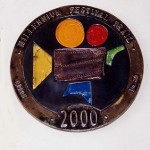
Like the Odeon York, the building of this theater was beset by delays due to the proposed placement within historic city walls and the discovery of Roman archeological remains (some of which were on display in glass cases in the upper foyer).
Chester and York Odeons are both different from other Odeon's being built at the time, in that they did not have the distinctive Odeon "Moderne" look externally due to the ruling of the Royal Fine Arts Commission not allowing the usual cream-tiled facia. Instead, the exterior is executed in a plain brick with horizontal and vertical channeling.
The signage was again different to the usual "Odeon" signs being rather larger and in "Trajan" lettering. Initially, the "ODEON" wording was at the top of the tower, and only later, was it moved lower.

Despite the external differences, the interior was very much in the "Moderne Streamline" style with clean simple lines directing the eye to the screen. The slopping ceiling had concealed lighting in recessed bands towards the screen with a ribbed curved plunge onto the proscenium frame. At either side of the proscenium there were tear-shaped lit recesses. The Chester Odeon demonstrates that "modern" architecture need not be the sort of passing fad that quickly dates and soon looks like a blot on the landscape.
In 1976 It was converted to a 3 screen from one single projection room, then again in 1991 2 more screens added, where the original upper projection-room was re-used. The Odeon was closed on 14th June 2007. Just as it it closed, the "Marquee Letter Board" on the front of the cinema was changed to read "GOODBYE: IM NEVER GONNA FORGET YOU" - a (perhaps double-edged) quote from the character Fabrizio De Rossi in the film "TITANIC".
It was purchased by Chester City Council in 2012 and has been altered to create "Storyhouse" - an 800-seat theatre, a small 100-seat single screen cinema and a library within the building.
- The Odeon at Chester Cinemas - includes much info and some video;
- Odeon Buildings at English Heritage;
- A far more detailed history on The Black & White Picture Place;
- "RE:NEW" the project to "transform Chester’s 1936 Odeon building into a new world-class theatre, library and cinema".
Northgate Development
For several years there has been much discussion about the redevelopment of the "Northgate" sector of the city, a project which has been the subject of many proposals, that have started, stalled, been abandoned or led to such hideous developments as some of the incarnations of "The Forum". Tracing the history of these, or event keeping up to date with the current state of development can be difficult. If you are looking for information on these and other developments here are some links:
- The Council's Chester Characterisation Study - a very interesting read on this and other parts of the city;
- Chester Archaeological Society page on conservation;
Beyond The Odeon
Beyond the Odeon, the character of Northgate Steet changes yet again. The east side of the street tends to be small shops, often of a specialist nature (selling things like hats, musical instruments and cheese) while the west side mostly comprises well established public houses of which many had been "coaching inns". There are some listed buildings and a few interesting stories to tell.

West (pub) Side
Number 53-55]
Numbers 53-55, Folliott House, was built for either James or W. H. Folliott in 1788 and originally at least a half again as large. Bricked-up former interior windows and doors can still be clearly seen on the blank wall. Folliott may have had some connection with the slave trade as he placed the following newspaper advert in 1770:
- RUN AWAY - A NEGRO MAN, named HOPE, the Property of Sir James Campbell, Bart. He carried off with him several Things of Value, and was drest in an old Green Shooting Jacket and Waistcoat, a pair of new Leather Breeches, Silver Knee and Shoe-buckles, and an old Gold-lac’d Hat, of his Master’s. He is about Nineteen Years of Age, thin Make, yellowish Complexion, about 5 feet 9 inches high, speaks very good English, and is marked on the right shoulder ISC. Whoever secures him, and lodges him in any Gaol, etc. will receive Five Guineas Reward, from Mr. James Folliott, Chester.
Just why Folliott placed this advert is unknown - he may even have been making a joke. There were several "James Campbell"'s around at the time but the then baronet, Sir James Campbell (d. 1814), appears to have been in Jamaica or the West Indies into the 1760's, serving in the 49th Regiment of Foot which was originally raised in Jamaica in 1745 - what his other activities might have been remains obscure.
Folliot House appears in the "news" again in 1833, when a resident of Northgate Street had part of the footway in front of his house enclosed with railings, thus infringing the long standing "right" of the pig and cattle drovers to use the streets to display their wares:
- "Among the new paving of the street and the flagging of the footways now in progress we notice the flagging and enclosure with iron railings of the space in front of the residence of the late Mr. Folliott in Northgate Street. This is certainly a very slightly improvement, but we understand the legality is likely to be questioned as an encroachment. The pig and cattle drovers who attend our fairs will put their claim of prescriptive right to the locus in quo, as part of the public street to exhibit their livestock for sale. It was only at the last horn and hoof fair that we saw a squad of "illigant pigs" snoozing in their litter on this very spot, underneath the parlor window. If we remember right, Mr. Folliott's coachman sailed out to lay the soft end of his whip upon the grunters, and got knocked down for the same by their owner on the principle strike me, strike my pig and when little Jehu came before the magistrates for redress, he was told that the Irish - man's illigant pigs had a right to disport themselves on the place in question, as part of a public street. As iron railings now render the spot more commodious, makes it in fact an admirable hog - style or shippon, as the circumstances may require, we would suggest, rather than forgo so ornamental an improvement and for the accommodation of all parties, that a compromise should take place between the owner of the premises and the pig - drovers , by the former taking down the entrance gate on every fair day."
The building was later the home of the architect Thomas Harrison, who designed the new outer bailey at Chester Castle and the Grosvenor Bridge. The building once housed the Citizens Advice Bureau, but is now extra accomodation for the Pied Bull, next door.
At one time a stone lion, standing victorious over a French eagle, was exhibited hereabouts. This was apparently made in 1815 for "Palmer's Exhibition" in Pall Mall and bore the motto "ANIMO NON ASTUTA" (by action not astuteness). It was intended to commemorate the recent vitory over Napoleon, and was supposedly later taken to the Grosvenor Arms at Aldford by a landlord of the Pied Bull - there is no sign of it at Aldford (the pub has two more modern lions).
The Pied Bull
Number 57: the Pied Bull, probably on the site of two medieval tenements ("Bull Tenement" - owned by the nuns of St Mary's convent), is a historic coaching inn. On the pillar at the front of the inn is a 1763 coaching sign giving the distances to London, Worcester, Ludlow, Bristol and Bath. The traveller George Borrow stayed here and he writes of it:
- "we put up at an old-fashioned inn in Northgate Street, to which we had been recommended; my wife and daughter ordered tea and its accompaniments, and I ordered ale, and that which always should accompany it, cheese. “The ale I shall find bad,” said I; Chester ale had a villainous character in the time of old Sion Tudor, who made a first-rate englyn upon it, and it has scarcely improved since; “but I shall have a treat in the cheese, Cheshire cheese has always been reckoned excellent, and now that I am in the capital of the cheese country, of course I shall have some of the very prime.” Well, the tea, loaf and butter made their appearance, and with them my cheese and ale. To my horror the cheese had much the appearance of soap of the commonest kind, which indeed I found it much resembled in taste, on putting a small portion into my mouth. “Ah,” said I, after I had opened the window and ejected the half-masticated morsel into the street, “those who wish to regale on good Cheshire cheese must not come to Chester, no more than those who wish to drink first-rate coffee must go to Mocha. I’ll now see whether the ale is drinkable;” so I took a little of the ale into my mouth, and instantly going to the window, spirted it out after the cheese."
and of the "strapping" chambermaids Borrow writes:
- "Upon the whole we found ourselves very comfortable in the old-fashioned inn, which was kept by a nice old-fashioned gentlewoman, with the assistance of three servants, namely, a “boots” and two strapping chambermaids, one of which was a Welsh girl, with whom I soon scraped acquaintance, not, I assure the reader, for the sake of the pretty Welsh eyes which she carried in her head, but for the sake of the pretty Welsh tongue which she carried in her mouth, from which I confess occasionally proceeded sounds which, however pretty, I was quite unable to understand."
Things have evidently improved since Borrow drank there, as the Pied Bull is now home to a prize-winning micro-brewery. The hotel rooms apparently retain quirky characteristics like sloping floors, so that if the earth did not move, the bed might.
The arcade over Northgate Street pavement has three segmental arches of stone with two storeys of Flemish bond brickwork above. Like the rest of the building this dates from early or mid 17thC. On the outside of this archway, by the corner of King Street is the sign mentioned above. Most of the historical features have been removed from the interior. The features retained include a large sandstone fireplace in the front room, which dates probably from the early or mid-17th century, and the 17th-century carved oak staircase.
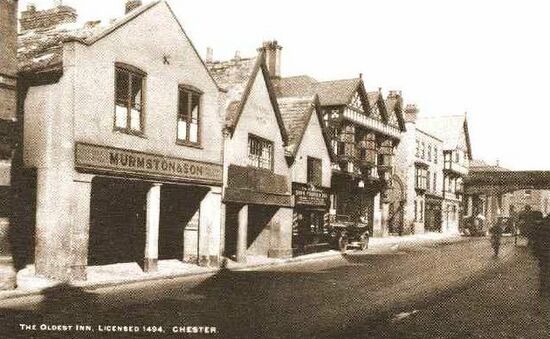
The Pied Bull claims to be the the oldest continuously licensed premises in Chester. In 1533 it was known as Bull Mansion, and a coach and four started to run from here to Birkenhead in 1784. The inn is mentioned in the Admiralty Records of 1804 as the inn where an armed and drunken Reverend Lucius Carey was attempting to gain access, when he was detained by the ex-Beadle. Carey got his revenge by having his detainer press-ganged.
Ghost(s)
The cellar is said to be haunted by the ghost of a cellarman from 1609 and two guest rooms are said to be haunted by a pair of chambermaids from 19th Century. The Chester coroners reports from 1609 confirm that:
- "John Davies .. casually fell down a flight of stairs leading to the cellar belonging to the Pied Bull, and with a knife in his hand .. and died"
As for the chambermaids, there is no record of their sudden death as is supposed to lead to hauntings, so maybe they are just the "strapping chambermaids" that were already immortalised by Borrow.
John and the chambermaids are not the only ghosts to be found in The Pied Bull:
- "A stableman fell asleep in the stables attached to the pub and burnt to death in the fire caused by his lit pipe and he still makes his presence felt in the ground floor rooms," explains Mary Ann Cameron, the author of "Chester: A City of Ghosts".
- Pied Bull on Wikipedia;
King Street
Between the "Pied Bull" and the "Red Lion" is elegant-looking King Street. This was formerly known as "Barn Lane" as it once led to a large Tithe Barn belonging to the Abbey. On the King Street wall of the Pied Bull is what looks like a sculpture based on the "Chester Imp" at the Cathedral. This is a part of the "Chester Imp Trail" and, not, as some seem to think, a "Fire Insurance Mark".
Red Lion
This pub moved here in 1795, but there may have been an earlier pub on the site (the pub claims to have been there since 1600). While it has been described as "notable by its black and white style of the Tudor period" the building is unlisted and the pillared arcade at the front probably dates to the 18th Century at the earliest (it clearly has the arcade in McGahey's 1855 "Balloon View"). It has its own story of a haunted cellar, a tale "emphatically retold by a previous landlady". Since then it has been a "Scruffy Muphy" Irish theme pub, but is now a conventional boozer again.


Number 63-65
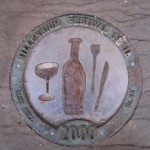
Numbers 63-65, formerly the "Bell" This is the best example, other than in The Rows, of a medieval town house in Chester. Until recently it was the "Blue Bell" restaurant, since then it has been a succession of other restaurants. The first record of "The Bell" is in 1399 when it was an inn, and it was granted a licence in 1494. It is said to be named after a "Curfew Bell" located in nearby "Bell Yard". The extension at the front was erected in 1684 by Elizabeth Halliwell as a barber's shop, which remained open until the 1920s. During the 18th century, this extension also served as a stage coach ticket office. The small window high on the building was used to sell tickets to passengers sitting on top of the coach. The "Bell" closed as a pub in 1930, when it was purchased by the City Council with the intention of demolition, but was left alone following protests. In 1960 the whole argument was again repeated and it again survived.
This was originally two houses and the frames of the two houses are separate, under parallel roofs with ridges at right angles to the street. The narrow space between is now occupied by stairs and lobbies joining the buildings.
The building between the Blue Bell and the former Fire Station is decorated with a Chester Imp.
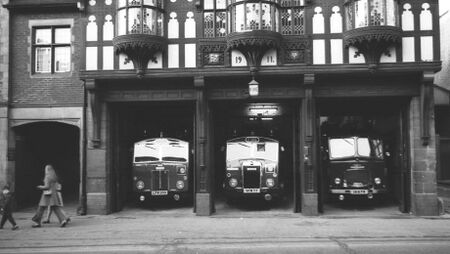
Old Fire Station
Originally, this was adjacent to the site of Chester's "Potato Market", and also that of the cistern erected by the water-works in c1828. The corporation had built an Engine House for the firemen there as early as 1828, as the engines had previously been based outside the City Walls near to the Gorse Stacks Cattle Market. They must have been moved there from their previous location adjacent the Abbey Gateway/Bishops Palace in Market Square at some point. Curiously the Potato Market was also once located by the Abbey Gateway.
The council bought the land off the west side of Northgate Street on which the fire station stood in 1900, and completed a new station, designed by James Strong as a half-timbered building with three arched entrances, in 1911. This building can still be seen at Number 73 and is now "Chez Jules" (French) Restaurant. Old cottages in Valentine's Court (now "Fireman's Square") behind the station were replaced in the 1920s with six firemen's cottages and a superintendent's house fronting Northgate Street. Firemen are sometimes superstitious and both the appliance room and the control room were said to be haunted by the bewhiskered "Fireman Jack" dressed in an old-fashioned Fireman's uniform complete with brass helmet:
- One night the Fireman manning the control room looked through the control room door's observation panel and said he saw Jack sitting on the old turntable ladder and smiling at him. He was so frightened that he immediately threw the bells on and turned out the watch. When the rest of the watch reached him they said he was white as a sheet.
Meanwhile in 1914 the city council's brigade was revived, consisting of a full-time superintendent and assistant, three sergeants and 18 firemen paid retaining fees, and an unpaid reserve, whereupon the Earl of Chester's Volunteers voluntarily disbanded. More full-time firemen were appointed in the 1920s and 1930s, starting with drivers, and the unpaid reserve was dispensed with in 1937.
The first motorized fire engine was bought in 1914. The brigade began providing a service for rural areas outside the city boundary c. 1920, and by 1937 covered Hoole urban district and Tarvin rural district, and was about to make similar arrangements with the rural district councils of Hawarden and Chester; in 1939 a substation was established at Ellesmere Port. As a preparation for war an auxiliary fire service was set up in 1938. On the formation of the National Fire Service in 1941 Chester's brigade was taken over by a district which included Liverpool and Wirral, and the city council regained control of the force only in 1947. It was apparent early in the 1950s that the Northgate Street fire station was too small and difficult of access, but a new station was opened only in 1970, on the site of the Northgate railway station goods yard. Responsibility for fire services was transferred from the city to the county council in 1974 under the 1972 Local Government Act.
Approaching Northgate
There is little to draw the eye of the passer-by in this final section leading up to the Northgate itself. The Liverpool Arms still stands on the site of the "Dog and Partridge", "Bull and Dog", "Wellington" and even the "Loggerheads Tavern", but there is no-longer any sign of the "Golden Falcon", "Golden Talbot" or "White Bull", and only a trace of the "Northgate Brewery" survives locally in a mosaic located on a terrace behind the glass office block next to the Northgate.
The Golden Falcon (also known as "Kenna's") has the following tales told of it by Hughes:
- In the year 1711, in the mayoralty of John Minshull, bookseller, the Duke of Ormonde, then Lord-Lieutenant of Ireland, in his journey to Parkgate, stopped at Kenna's, till the wind served for him to proceed on his jou)mey. On the morning when he and his suite were setting off, one of the waiters ran after a servant of his Excellency to demand payment for some articles which he had omitted to discharge. The servant refused to' pay, and the waiter, holding bis horse's bridle, insisted on being paid before he would quit his hold ; upon which the servant drew a pistol from his holsters, and shot the waiter dead upon the spot. Upon the man being imprisoned, the Lord-Lieutenant directed that if he should be convicted, an express should immediately be sent to him, that he might apply to the king for his pardon. The prisoner was tried and found guilty ; and the Mayor being informed of the directions of the Lord-Lieutenant, replied, "I will take care to save his Majesty and the Lord-Lieutenant any further trouble in this matter"; and ordered the man to be executed the next day after his conviction.
The second tale is as follows:
- Mr. Samuel Jarvis was a ribbon weaver, kept a small shop under Shoemakers' Bow, opposite the Theatre, and lived in a little house adjoining the Falcon Inn. It was observed, however, that this individual suddenly emerged from poverty and obscurity to respectability and affluence, without the appearance of any intermediate change of circumstances. It is said that an opulent banking-house in London had been robbed of a large sum of money by one of the clerks, who, absconding with the property, came down to Chester, and took up his domicile at the Falcon. He was pursued, and at a late hour one night, whilst he was in bed, he heard his pursuers below stairs ; upon which he rose up, threw the bags containing his treasure through the chamber window, which looked into a small area belonging to Mr. Jarvis's house, and went to bed again. He was secured and conveyed to London, but none of the property having been found upon him, he escaped conviction ; but subsequently, for another offence, he was found guilty and executed.. It is added, that Mr. Jarvis found the bags in the morning in the area, a circumstance corroborated by the fact, that he immediately after commenced as a silk mercer in a very extensive line. He also purchased a large estate at Mollington, near Chester, where he built a handsome house, lately occupied by Mr. Roberts. He dying without issue, his property came to a person of the name of Dob, a gardener at Greg's Pit, near the Bowling Green, whose descendants in the second generation had squandered the property, and left no male issue. Mr. Jarvis served the office of Mayor of Chester in 1742-3 ; and at the time of his death was pricked down for High Sheriff of the county the ensuing year. He was buried near the baptismal font in St. Oswald's Church.
Handel in Chester
Hughes also adds (of the Golden Falcon):
- "Handel lodged while staying in Chester for three or four days in 1741.. .. Here, too, in 1769, his Royal Highness the Duke of Cumberland is recorded to have put up, when he came to Chester, to pursue his celebrated intrigue with Lady Henrietta Grosvenor. On the death of Mrs. Kenna, the hotel was newly fitted up by Mr. George Smith, owner at that period of both the White Lion and Golden Falcon, the initials of whose name, with the date 1703, and the effigies of the Falcon,* yet remain upon the water-spouts at the back of the premises. In this house, on January 11, 1772, was held a Chapter of the now unknown " Most Ancient and Honourable Order of Hiccabites." It appears by the advertisement summoning the Chapter, in the Chester Courant of that day, that, unlike most other secret Orders, sisters as well as brothers were admitted into the fraternity. Under the new regime, however, it ceased to maintain its previous high character, and after doing duty for a time as a Vinegar Manufactory, became eventually metamorphosed into what we now know as Eaton's Brewery. Several Roman remains of interest have of late years been discovered in the rear of these premises."
George Frederic Handel (1685-1759) wrote his "Messiah" to provide funding so that he could recover from serious debt. He had been gravely ill and half-paralysed after a stroke in April 1737 and unable to work. It was even thought by his doctor that he would never write again. The "Messiah" was almost never written, in 1740 he initially tore up the libretto proposed by Charles Jennens (who was educated at the King's School Chester), but then returned to it and over three weeks largely completed the composition of the oratorio. The first rehersal of it was in Chester in November 1741. Handel was staying at the Golden Falcon in Northgate Street, on his way to Dublin, where the first public performance was to take place, but weather conditions meant that he could not embark from Parkgate for several days. At something of a loose end, Handel made enquires at the Cathedral as to whether they had any "choirmen" who could sing from a sight-read score. Having been advised that this was certainly the case a rehersal was arranged at the Golden Falcon, but turned out to be something of a farce, as the lead bass could not, in fact, sing from a score. According to the music historian Charles Burney (also educated at the King's School, Chester), on "An Account of the Musical Performances...in Commemoration of Handel" (1785), Handel lost his temper, swore in four or five languages, and cried out in broken English:
- "You shcauntrel ! tit not you dell me dat you could sing at soite" (You scoundrel! Did you not tell me you could sing at sight?)
Janson, the bass, replied "Yes, sir, and so I can: but not at first sight."
Handel never sailed from Parkgate. Burney is correct that Handel intended to sail from there, but at the time Burney was just a schoolboy and he failed to add that because of continuing bad weather, the composer eventually sailed from Holyhead.
The premier performance of "Messiah" in Dublin April 13, 1742, received rave reviews and exceeded expectations raising 400 pounds and freeing 142 men from debtor’s prison. The charity sponsors, hoping to squeeze in additional paying patrons, asked the ladies to refrain from wearing hoops under their skirts and encouraged men to leave their swords at home. Jennens was less than wholly approving of the musical setting, writing to Edward Holdsworth:
- "I shall show you a collection I gave Handel, called Messiah, which I value highly. He has made a fine entertainment of it, though not near so good as he might and ought to have done. I have with great difficulty made him correct some of the grossest faults in the composition; but he retained his overture obstinately, in which there are some passages far unworthy of Handel, but much more unworthy of the Messiah."
The Northgate
Hemingway describes the older Northgate as follows:
- This ancient gate adjoining which was a mean and ruinous gaol was an inconvenient and unseemly pile of building It consisted of a dark narrow passage under a pointed arch with a postern on the east side and the entrance to the prison Immediately under the gate way at the depth of some thirty feet from the level of the street was a horrible dungeon to which the only access of air was through pipes which communicated with the street In this frightful hole prisoners under sentence of death were confined itself a living death.
The new Northgate was built in place of the former medieval Gatehouse in 1810 by County architect Thomas Harrison for the City Council. Hemingway describes the new Northgate thus:
- A handsome structure forming a capacious eliptic arch of white stone of the Doric order divided from two smaller ones at the sides by two pillars it was erected in 1808 on the demolition of the old one when the city gaol which also stood here was taken down and the prisoners removed to a new building erected on the south side of the infirmary The design was furnished by Thomas Harrison Esq the county architect and the ceremony of laying the first stone was attended by Earl Grosvenor and the Mayor and Corporation the whole being executed at the sole expense of the former individual now Marquis of Westminster.
East (shop) Side
The East Side of Northgate Street after the Little Abbey Gateway contains comparatively little of historical interest. However, there are some well-preserved shop-fronts, several of which retain the sort of roller-awnings that are seldom seen nowadays and these are still in use in sunny weather. The mechanics by which these awnings operate varies from the simple to the moderately complex. Number 100-102 are listed, as are 104-110, 128-132 and 134-138.
Beyond Northgate
Northgate is described in detail on the pages relating to the City Walls. It is definiitely worth climbing up the stairs onto the gate for the view, especially that of the chasm crossed by the Canal Bridge. The Canal Bridge iteslf is the best place to view the Bridge of Sighs: a footbridge was used to take prisoners from the City gaol (previously on the site of the Toll Collage at No.1 Upper Northgate Street) to the former Chapel of St John in the south wing of St John's Hospital for prayers prior to execution. It has been suggested that friends of such prisoners frequently staged attempts to free them when they were taken for their last walk by the road route. In 1793, in order to foil such attempts, the authorities built this small bridge, seen today without it's rails.
The bell visible on the corner of the building is that of the SS Galeka, of which the history is told on the St John's Hospital page. Looking north from the top of the Northgate one sees a building with a glass observation coupola, which was the home of the once owner of the Chester Chronicle newspaper John Fletcher.
- Cheshire Magazine on the Bridge of Sighs;
- Bridge of Sighs on Wikipedia;
- Bridge of Sighs on English Heritage;
- Northgate Bridge on English Heritage;
- the Toll-Cottage on English Heritage;

By the 13th century development had extended outside of the Northgate, but this was the smallest of the City's suburbs. Apart from the hospital of St. John, whose precinct occupied a narrow strip of land extending westwards from the gate outside the town ditch, most of the area belonged to the monks of St. Werburgh's. The suburb's main axis lay along Upper Northgate Street, the road north into the Wirral, which from early times forked to form Bache Way (later Liverpool Road) running north, and Mollington Lane (later Parkgate Road) running northwest. At the fork, the Lavaux Map indicates the presence of the Northgate May Pole. This maypole is mentioned in Ormerod:
- "Two tall Maypoles are yet [1816] remaining in Handbridge [but since 1816 have been taken down]; another which was placed at the end of Further Northgate street has been removed; but the women and children still [1816] deck out garlands on the accustomed day, and suspend them at the doors near it, following passengers with vociferous demands to "remember the May Pole" [This custom has for some years been discontinued]."
The Northgate suburb also contained a stone cross and buildings belonging to the Abbey, of which the most important were St Thomas's Chapel with its graveyard, at the fork terminating Upper Northgate Street, and the abbey's tithe barn on Mollington Lane. The land on either side of Upper Northgate Street, from Portpool Way (renamed Cottage Street, later Garden Lane) to Windmill Lane (now Victoria Road) formed gardens, mostly the property of Chester Abbey and including the "Battle Croft", whose name implies that it was the site of judicial battle in the form of "trial by combat" in the Middle Ages. Beyond lay open fields extending to the northern limits.
Opposite the end of Delamere Street stands an 18th century property fronted by a street level arcade. This was the home of Lady Elizabeth Otway who was associated with the Bluecoat Girls School in around 1718. By the mid 1840's the house was occupied by Reverend William Harrison who was the heatmaster of a private school located on the opposite side of Northgate Street. In the middle of the front of the building is a "Sun" fire-insurance plate. The "Sun Fire Office" was the first company to use these plates and is the oldest documented insurance company in the world, founded in 1710. For most of the 18th century, each insurance company maintained its own fire brigade, which extinguished fires in those buildings insured by the company and, in return for a fee to be paid later, in buildings insured by other companies. By 1825, fire marks served more as advertisements than as useful identifying marks; some insurance companies no longer issued fire marks, and those that did sometimes left them up after a policy had expired.
The Bull and Stirrup was designed by W. M. Boden and its features reflect those of No.3 Northgate Street opposite, by Lockwood.
After 1840 more exclusive suburbs began to develop along Liverpool Road, as it did south of the River. Most of the land on either side of the Parkgate Road and Liverpool Road as far as the Bache boundary belonged to the Dean and was known as the Bailiwick estate. In 1845, as a consequence of the Cathedrals Act of 1840, it passed to the Ecclesiastical Commissioners, who began to sell building plots on which covenants controlled the value and nature of development. It became an attractive area for suburban villas, and development before the early 1870s was almost exclusively of substantial houses set in large gardens - beyond the fork of Liverpool Road and Parkgate Road lay a triangular area occupied by generally high-status residents and their servants. The area became a rival to the leafy suburbs south of the Dee and largely retained that character until 1914. Its bisection in 1890 by the Northgate-Shotton railway and Liverpool Road station, however, led to some undermining of its status, and building east of Liverpool Road and north of Brook Lane between 1890 and 1914 was mainly of terraces and semi-detached houses.
Speculative houses of higher quality, detached and semi-detached and still Edwardian in style, were built from 1935. Small pockets of land on and just off Parkgate Road and Liverpool Road, north of the centre, were developed with tight closes, for example Abbots Grange of 1929. Some houses were also being built in the former gardens of larger houses, as at Abbots Park. The building of houses for individual clients seems to have reached a peak throughout Chester in 1936-7, after which mass house-building predominated.


